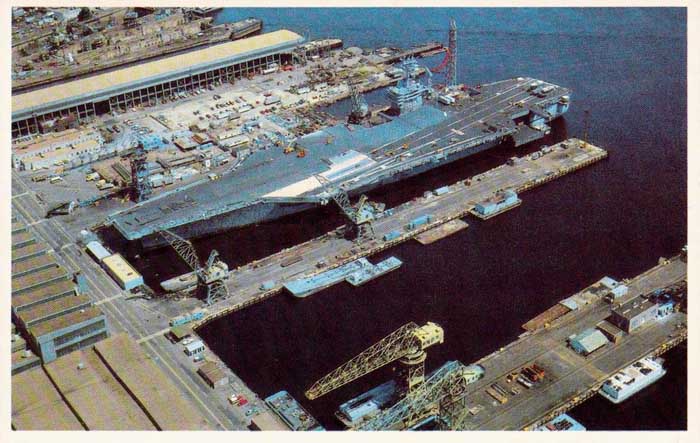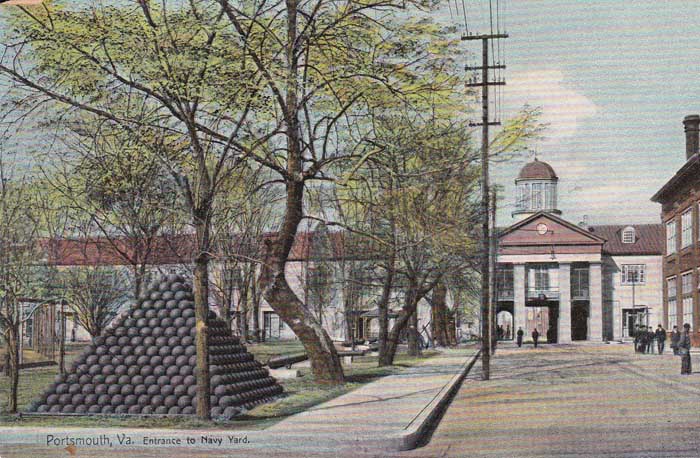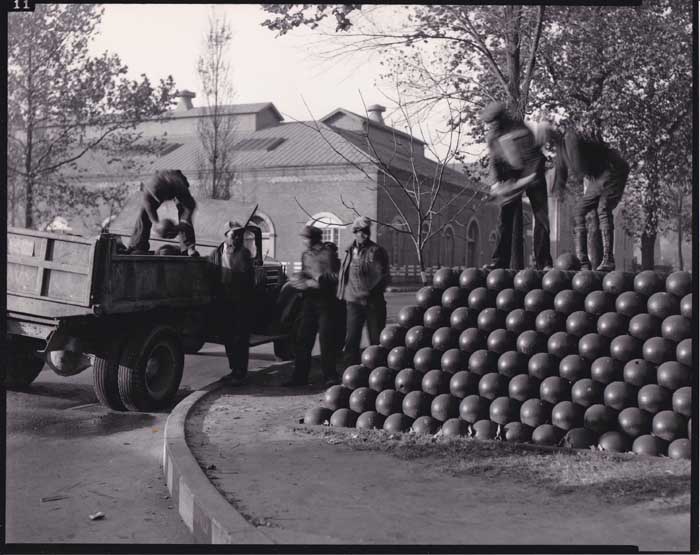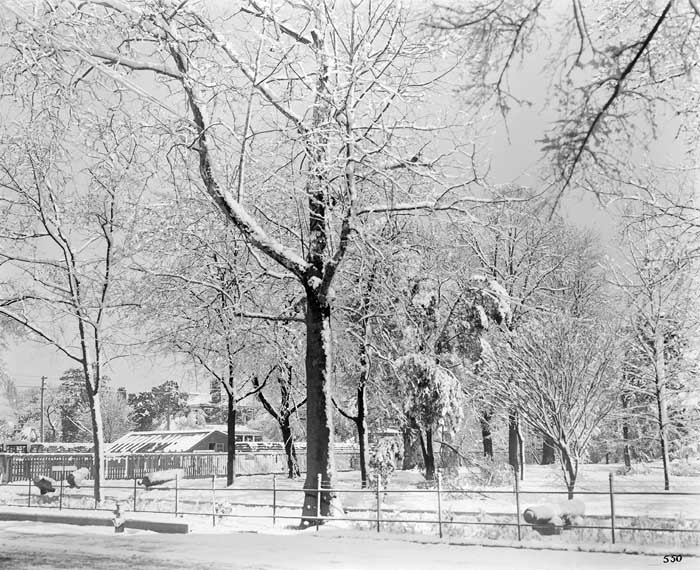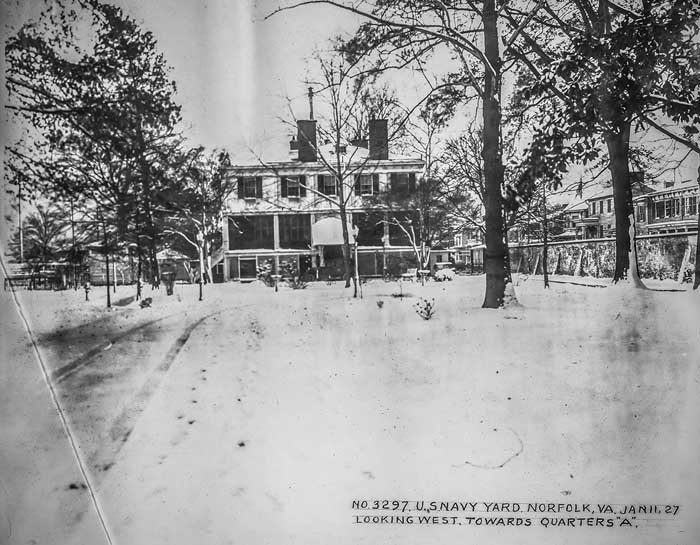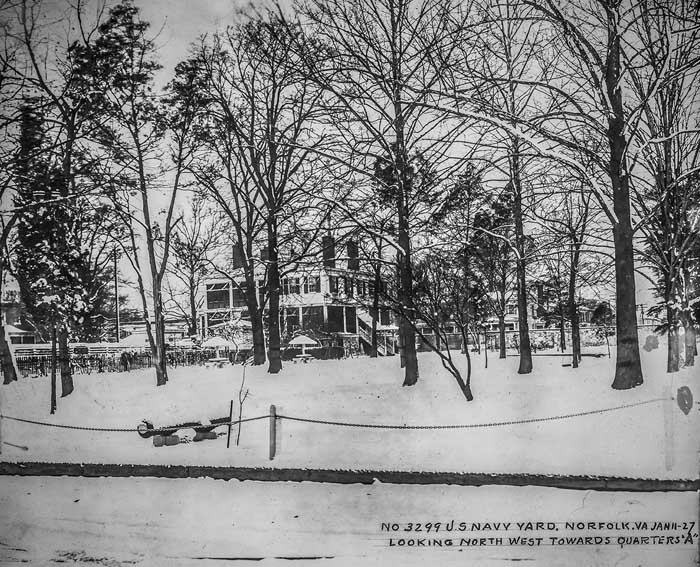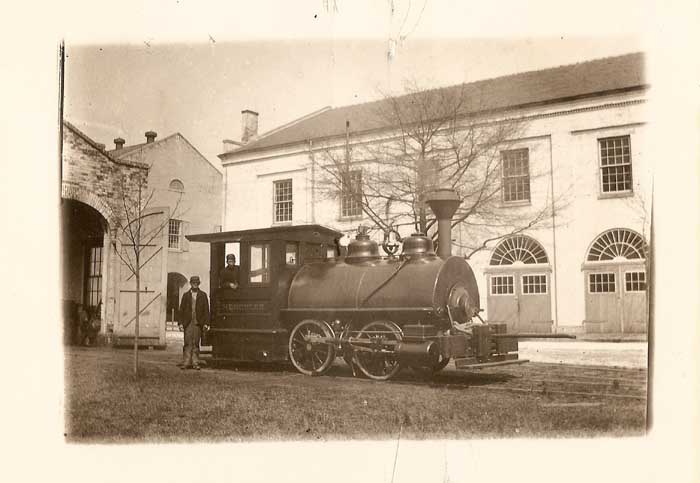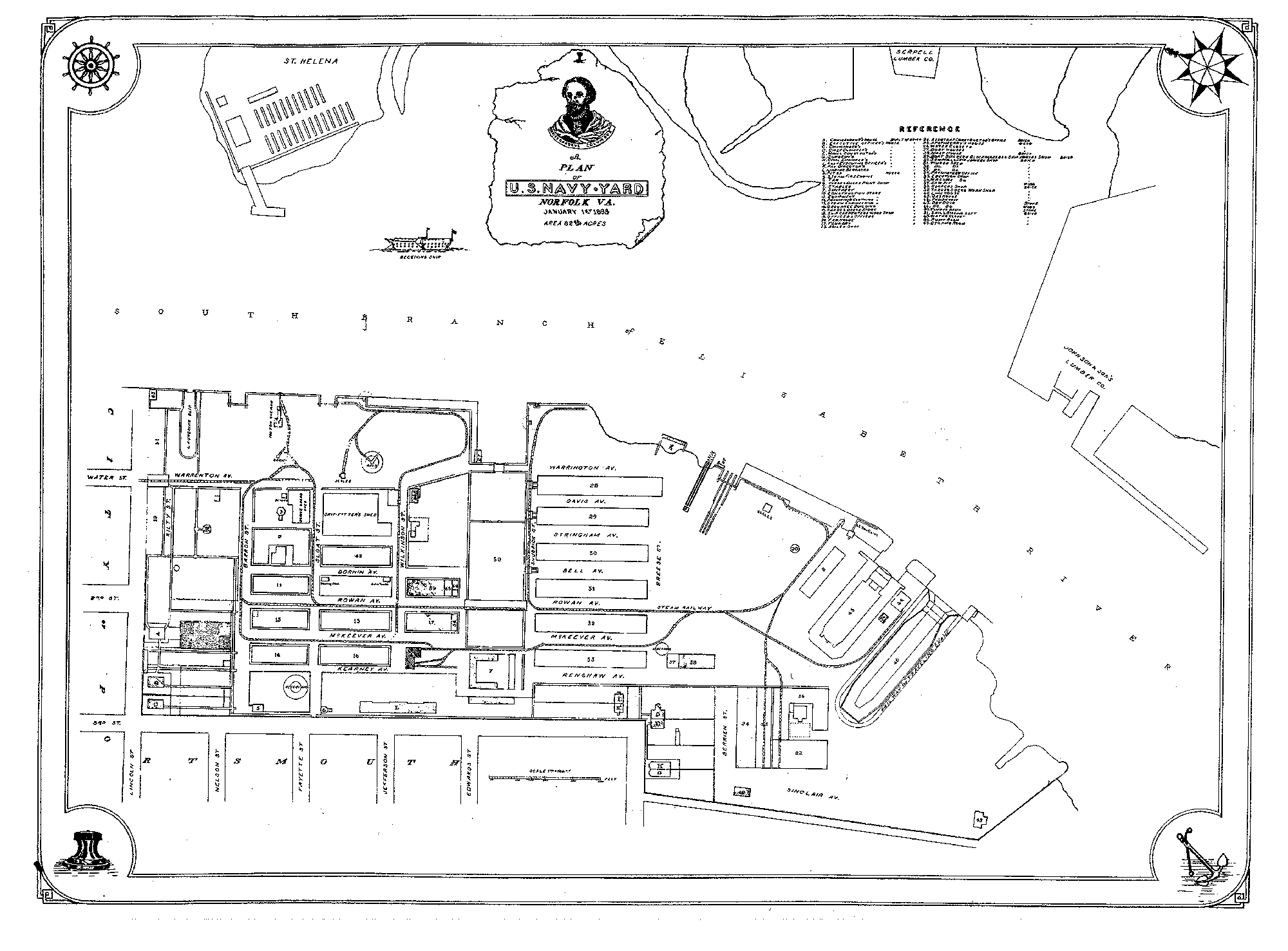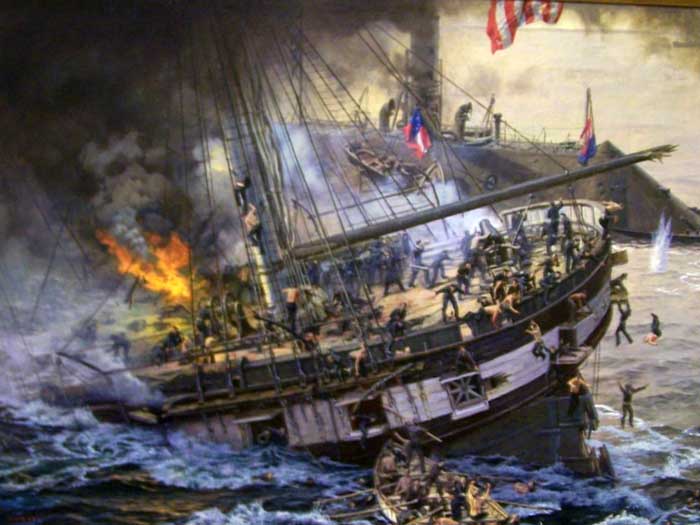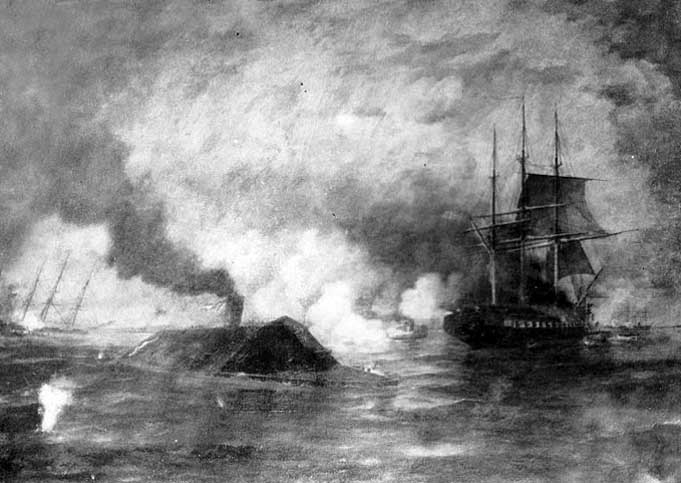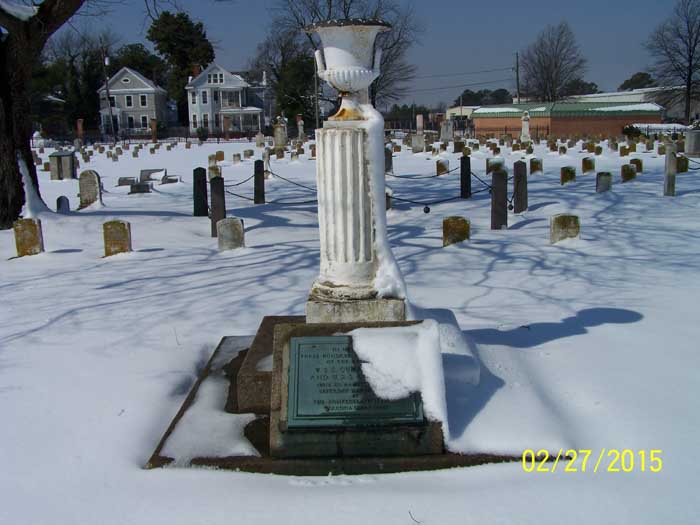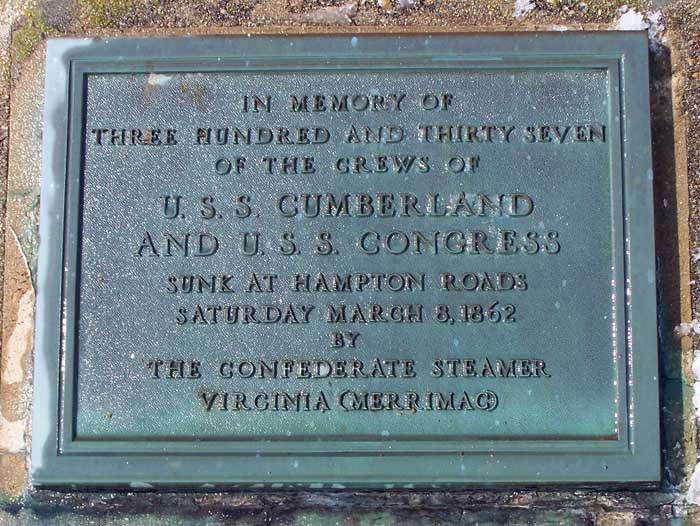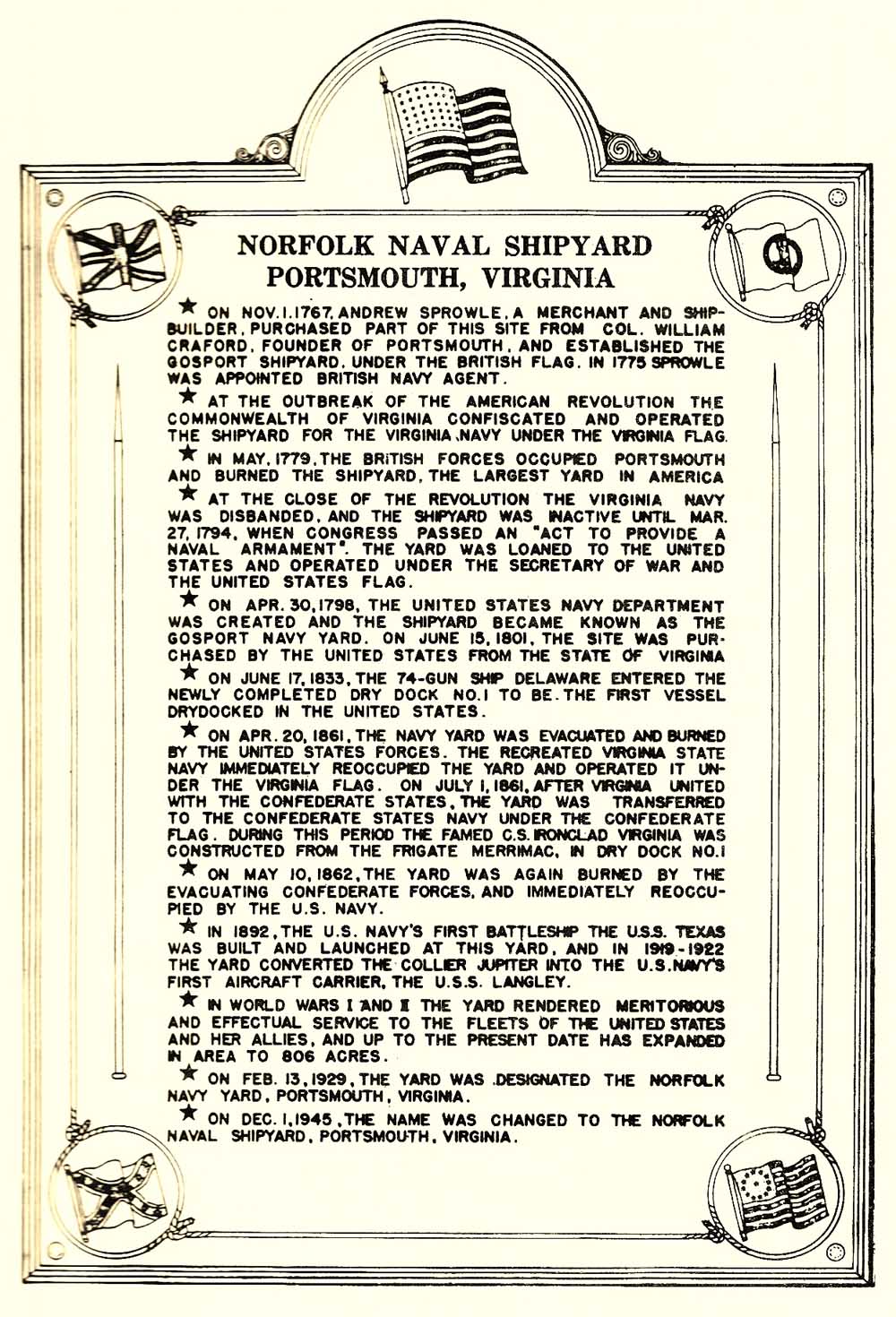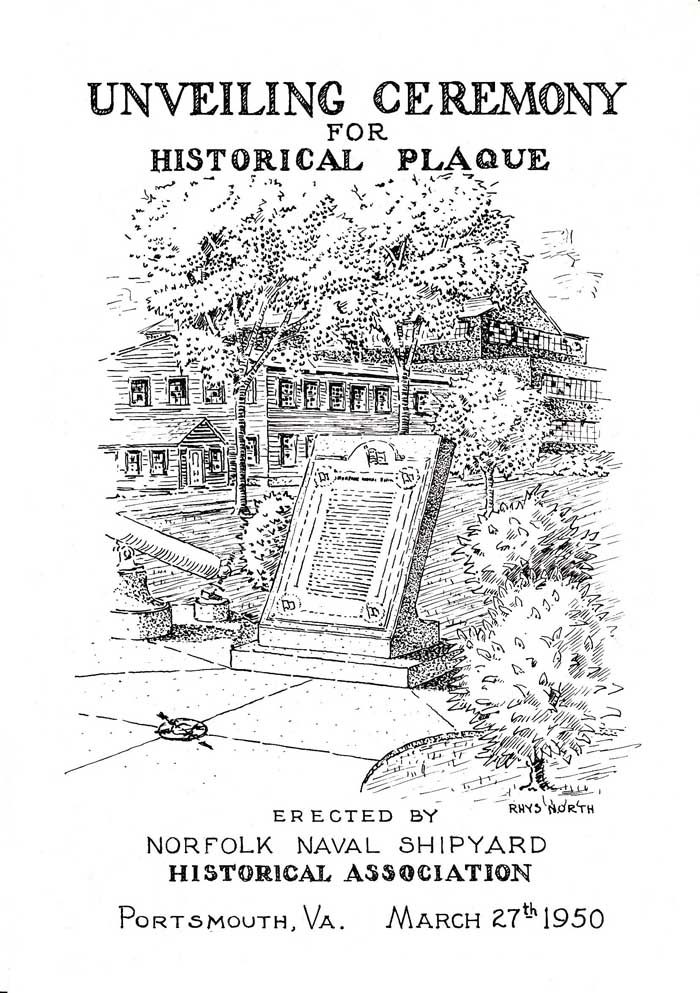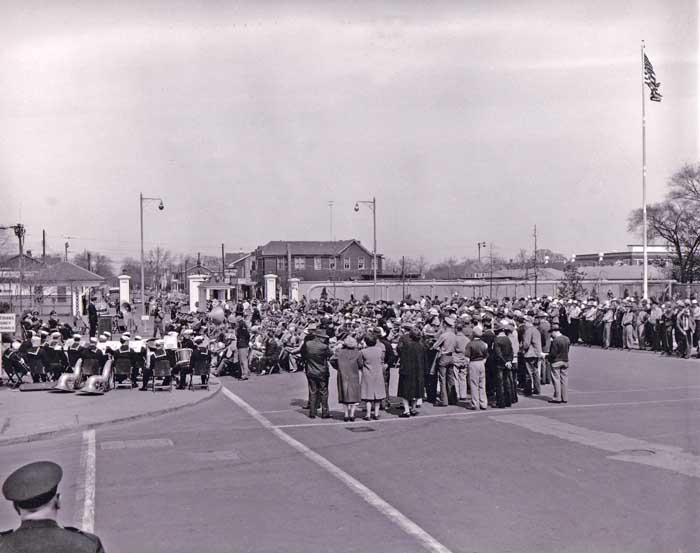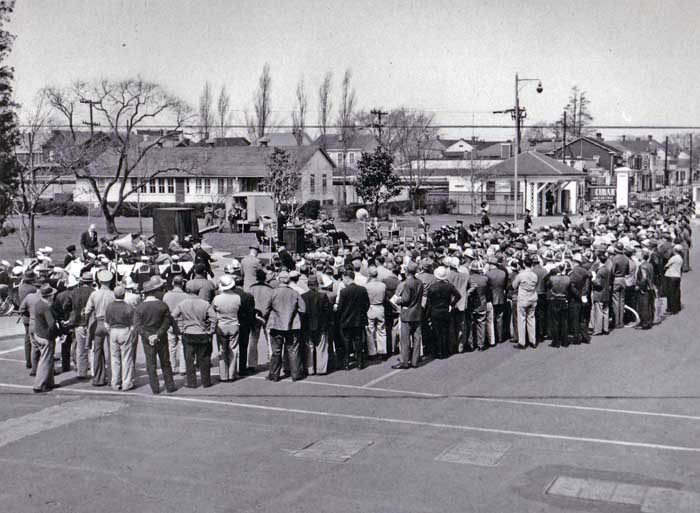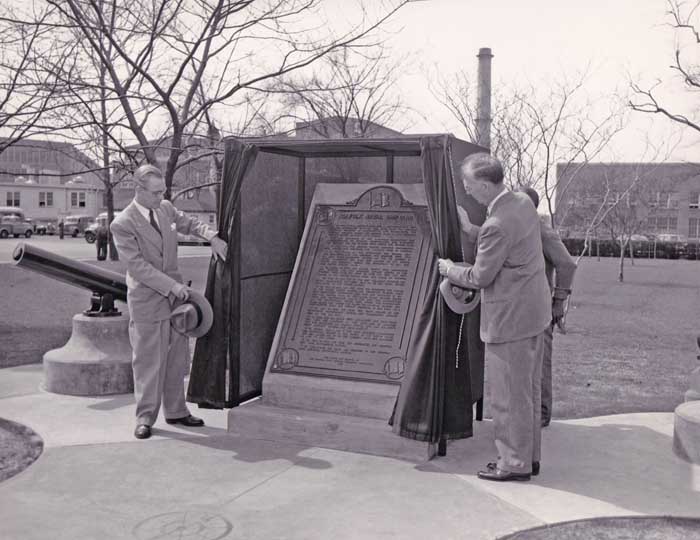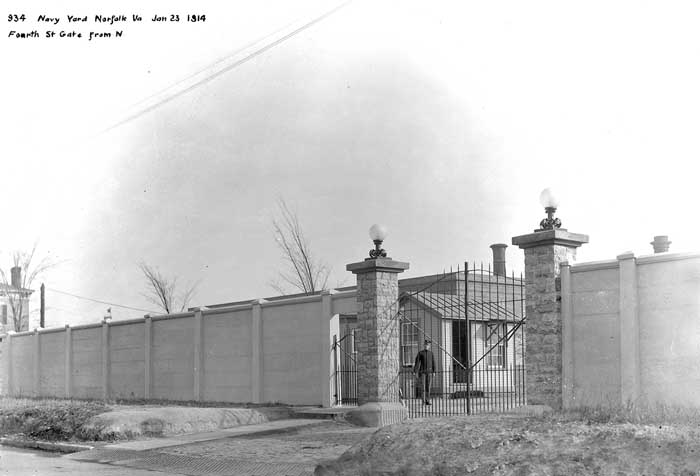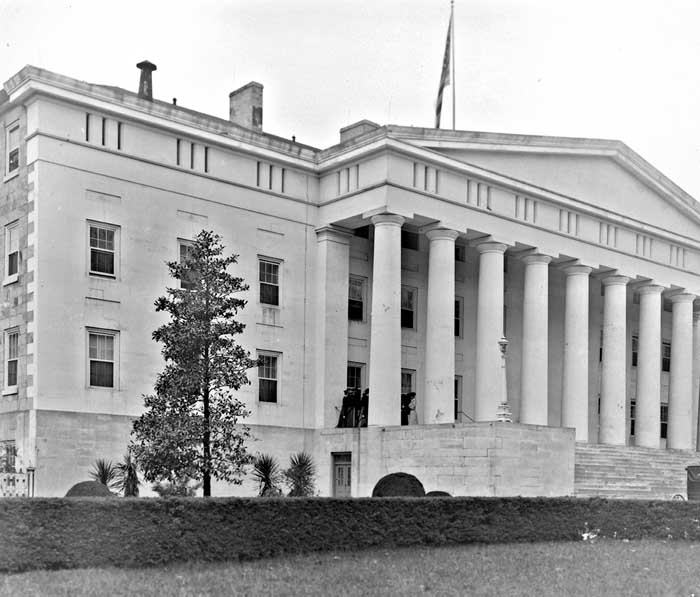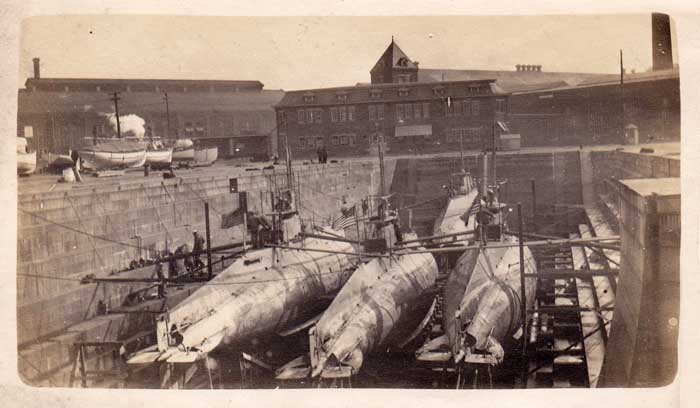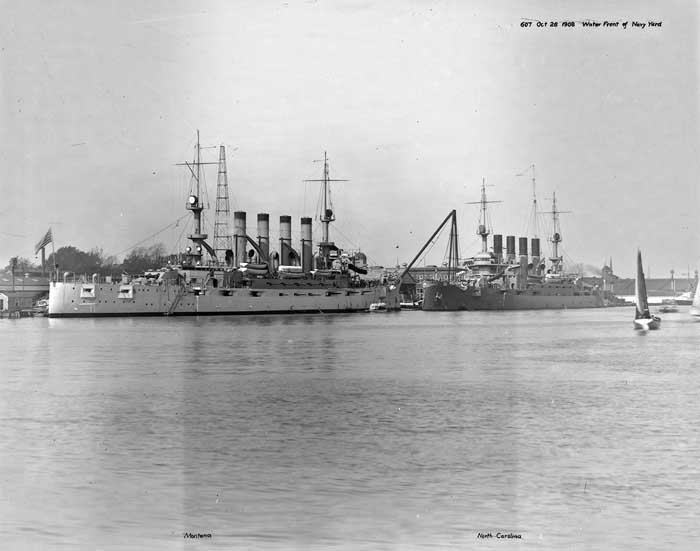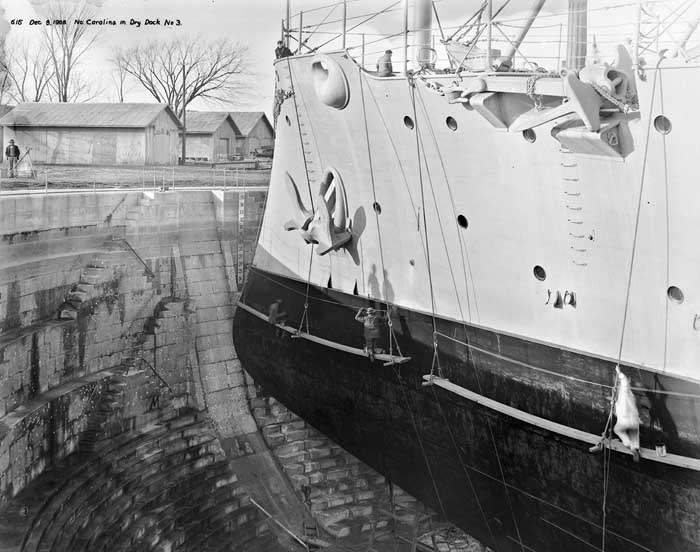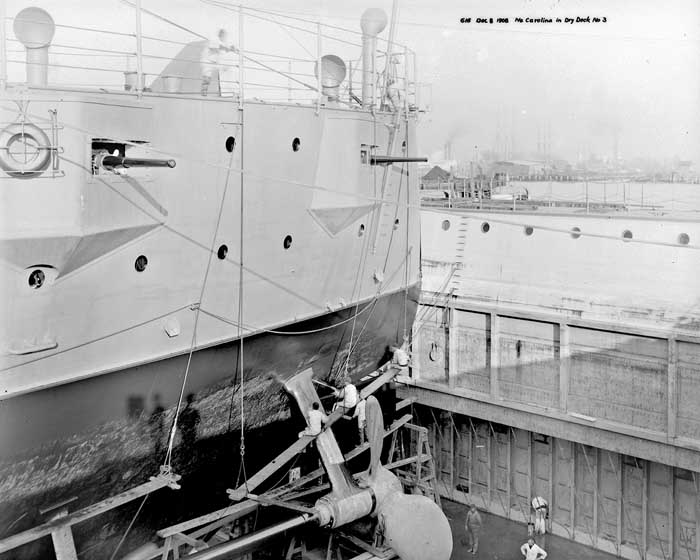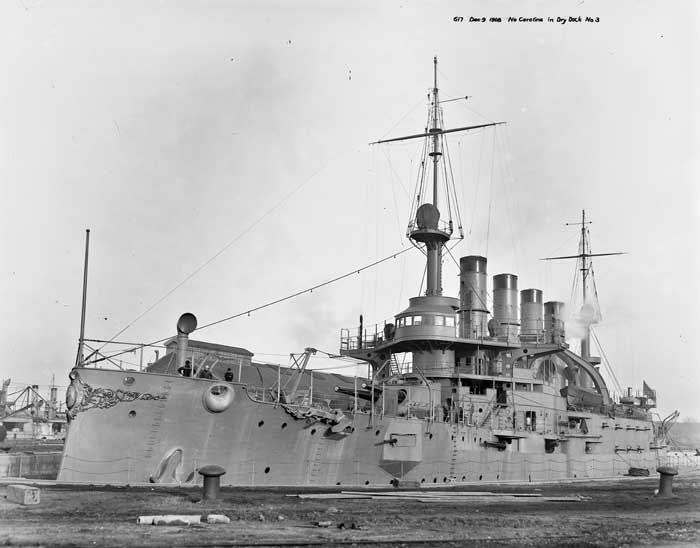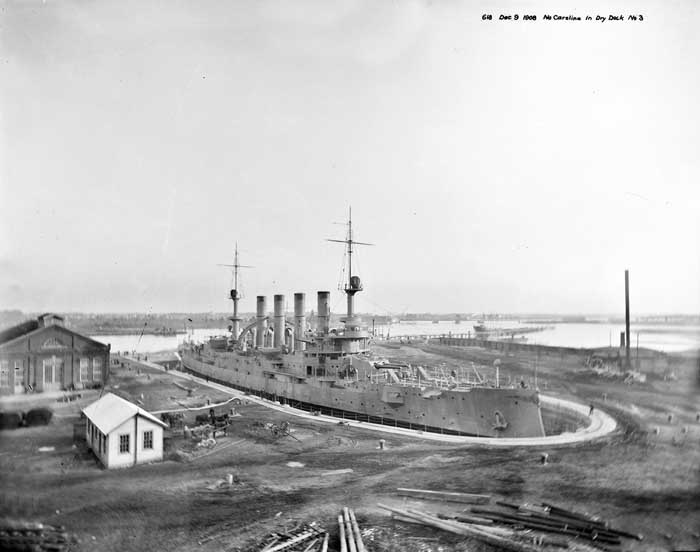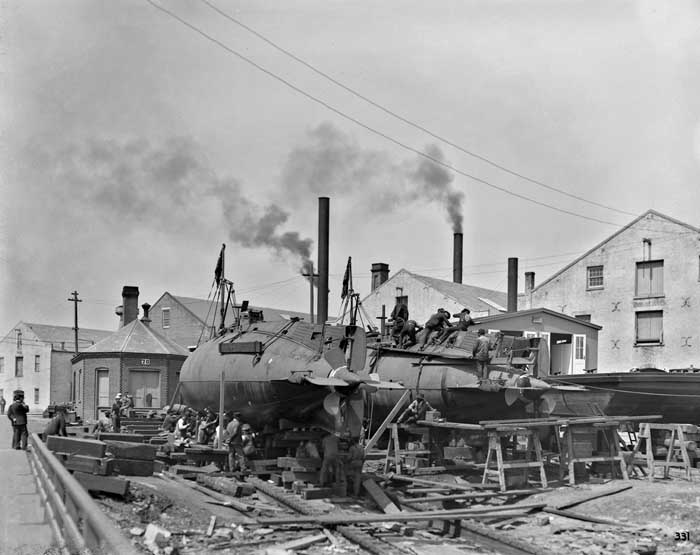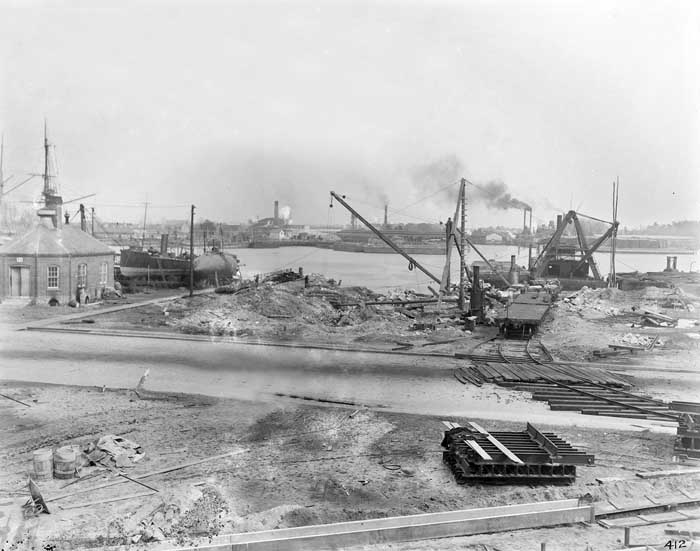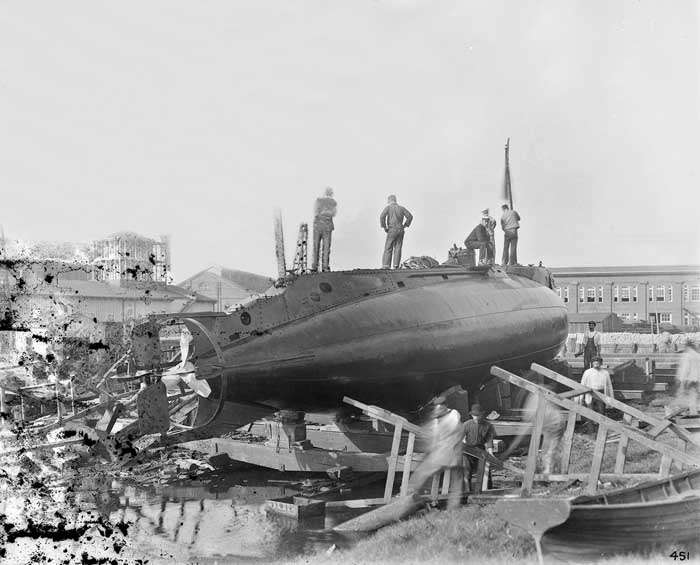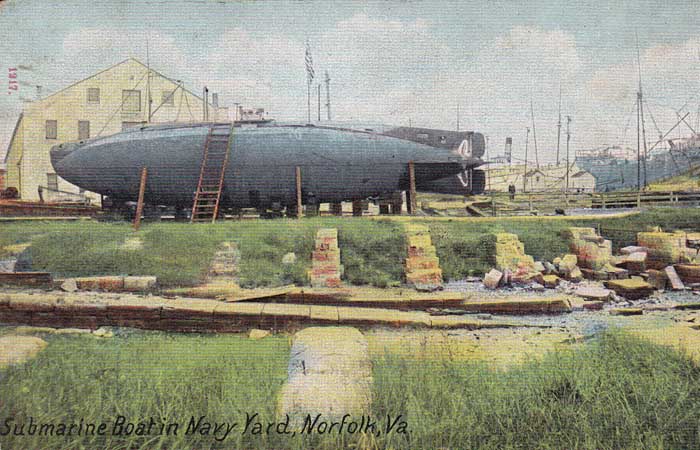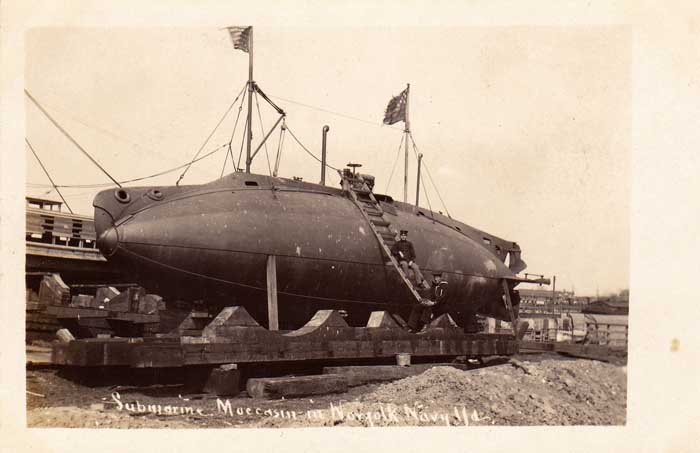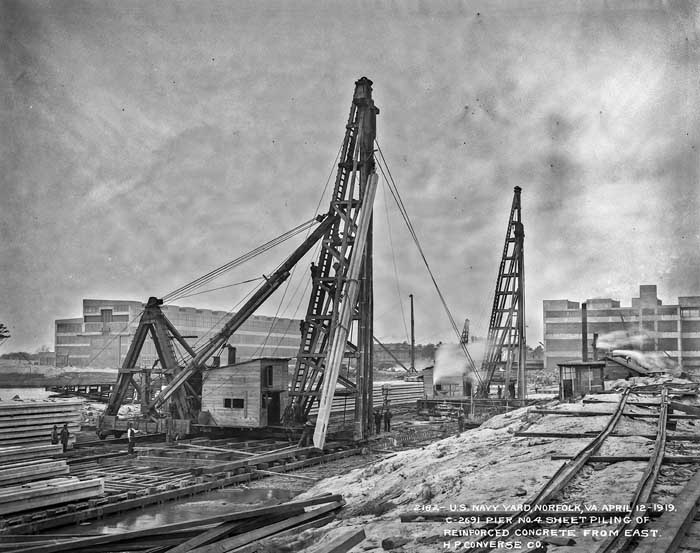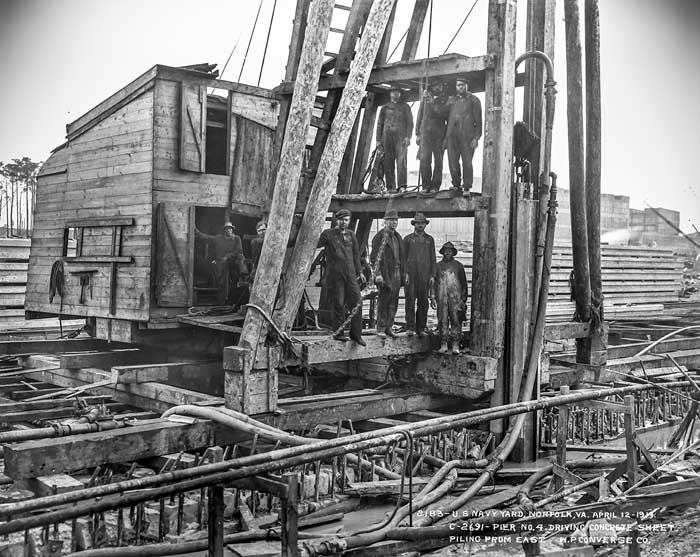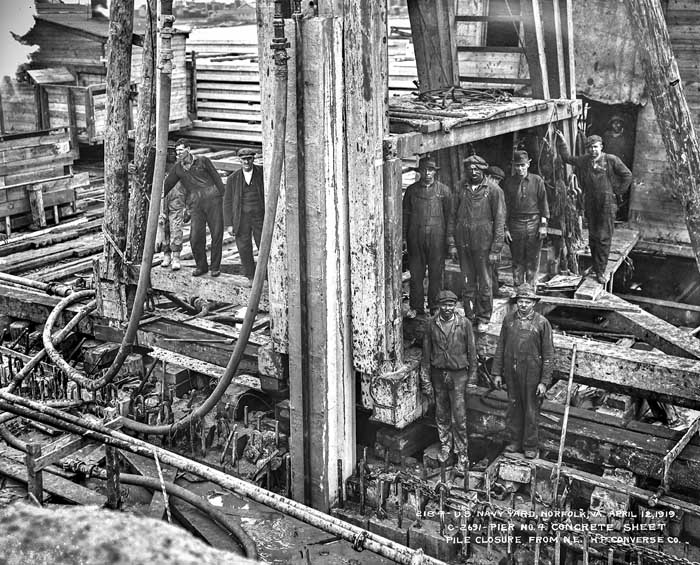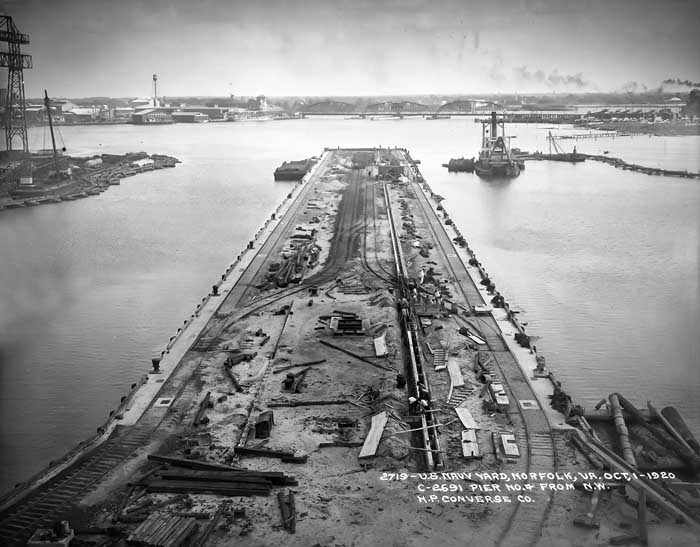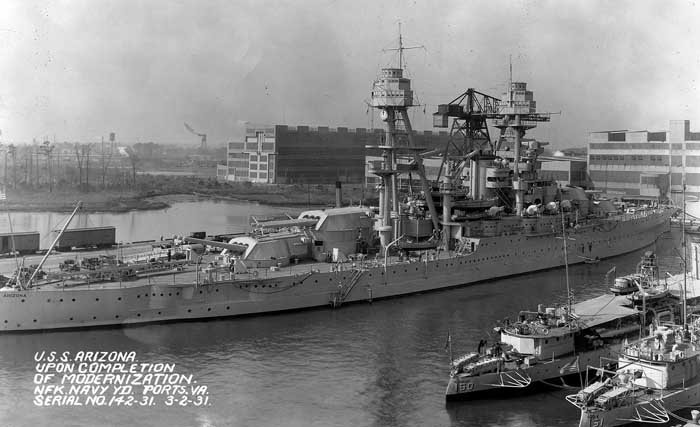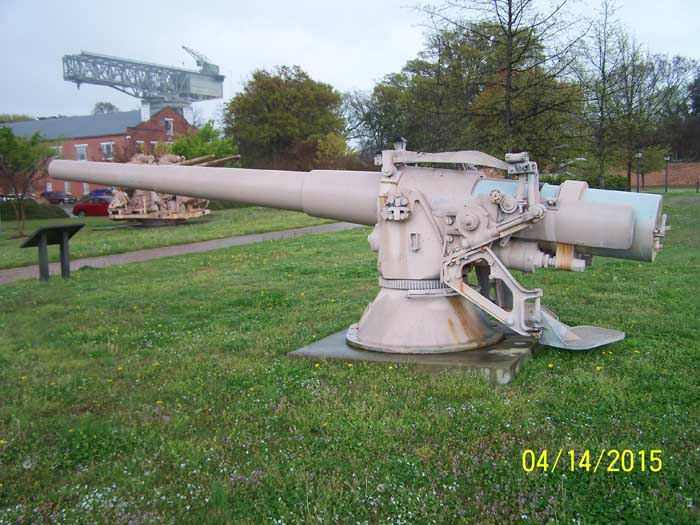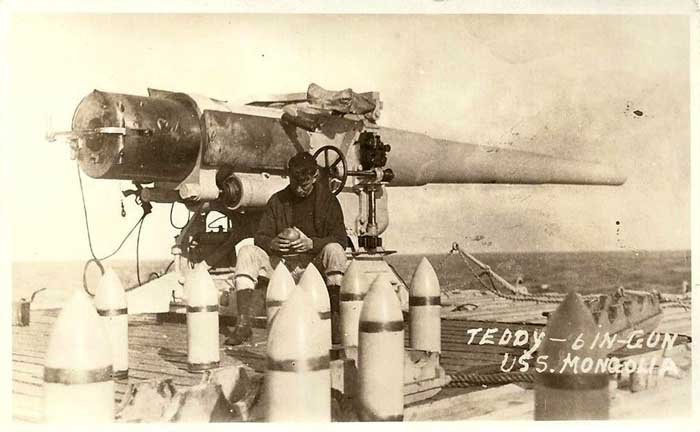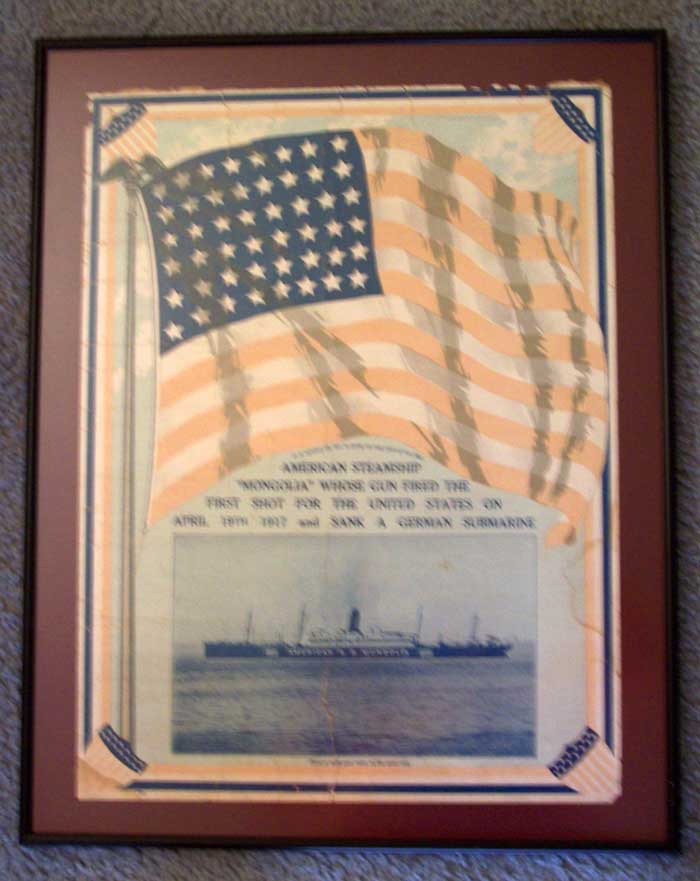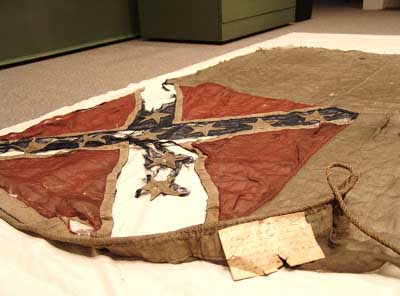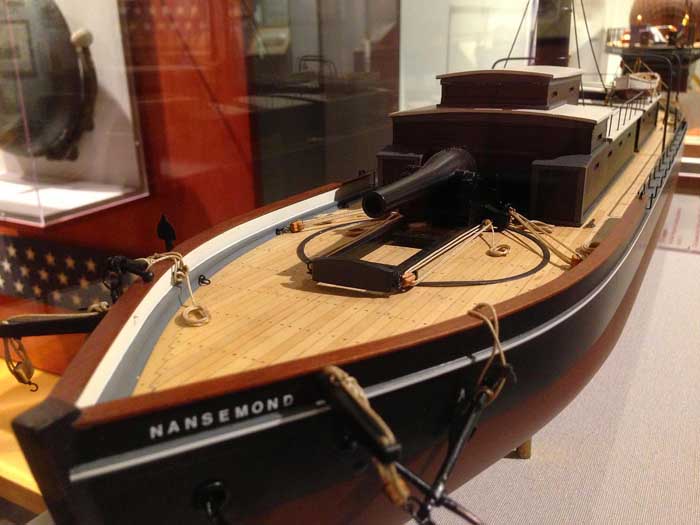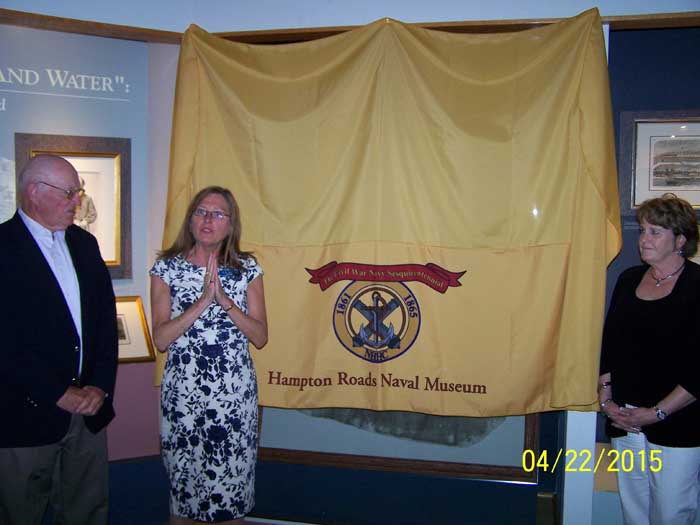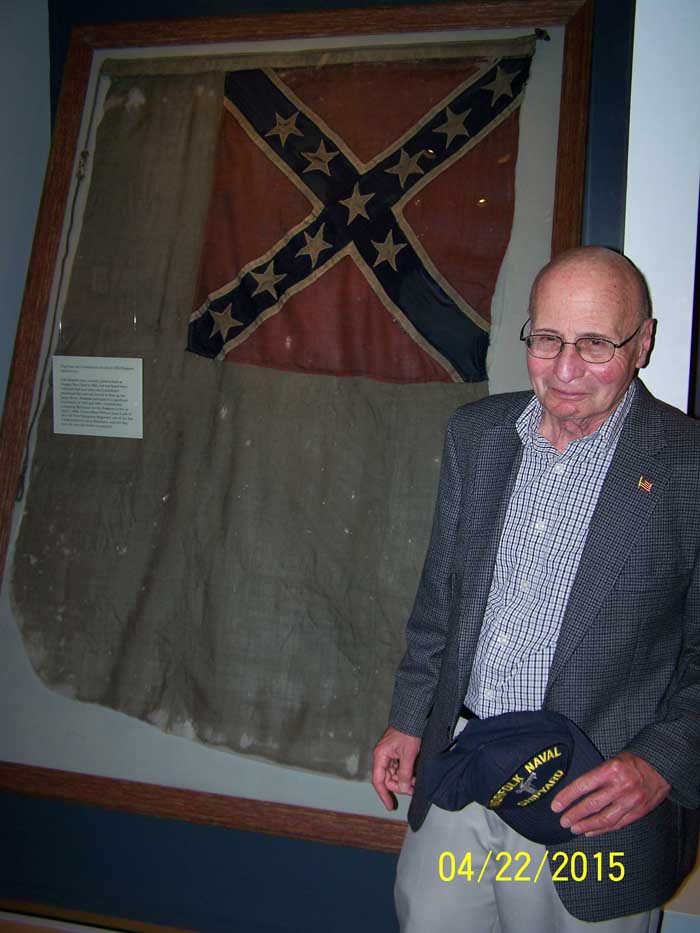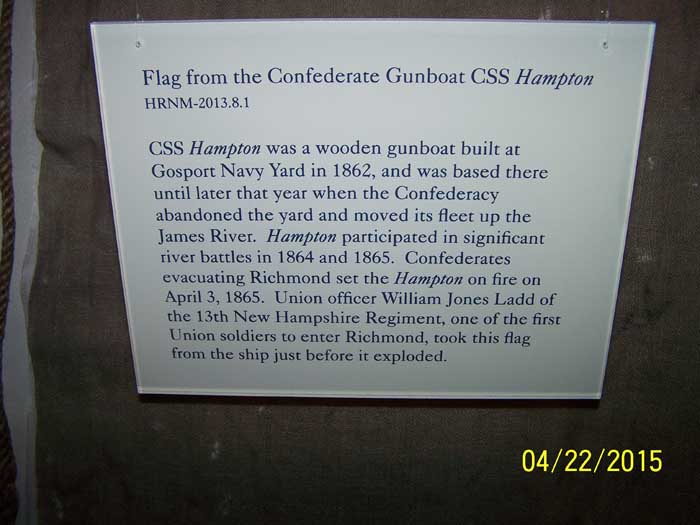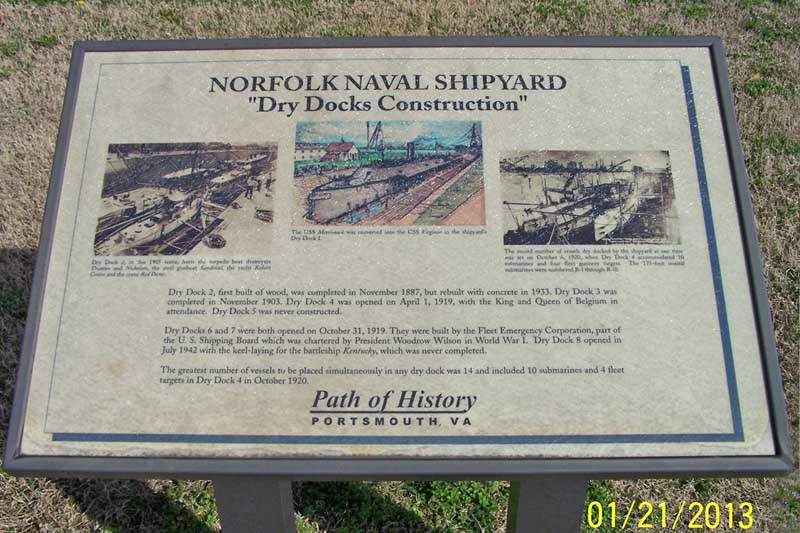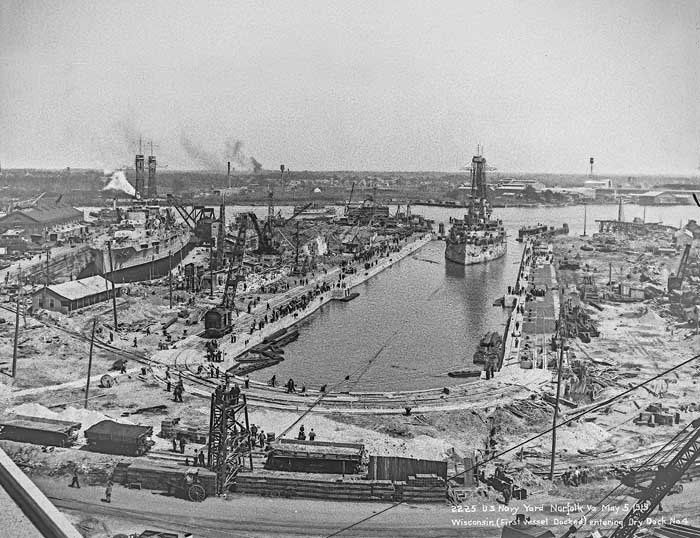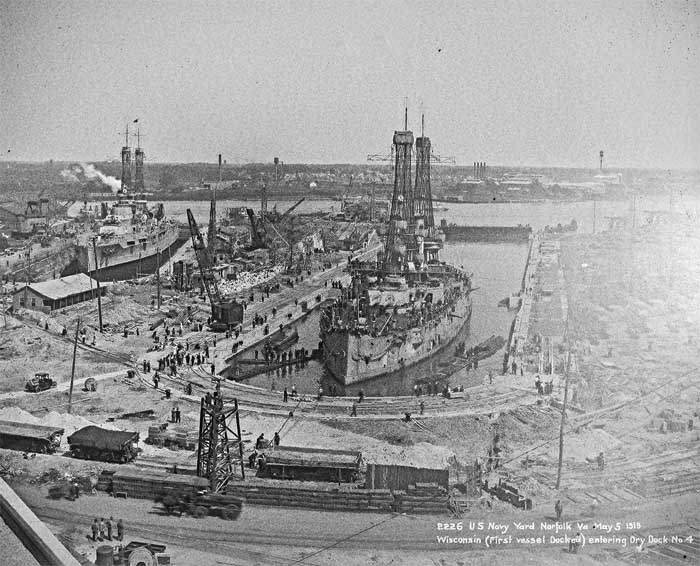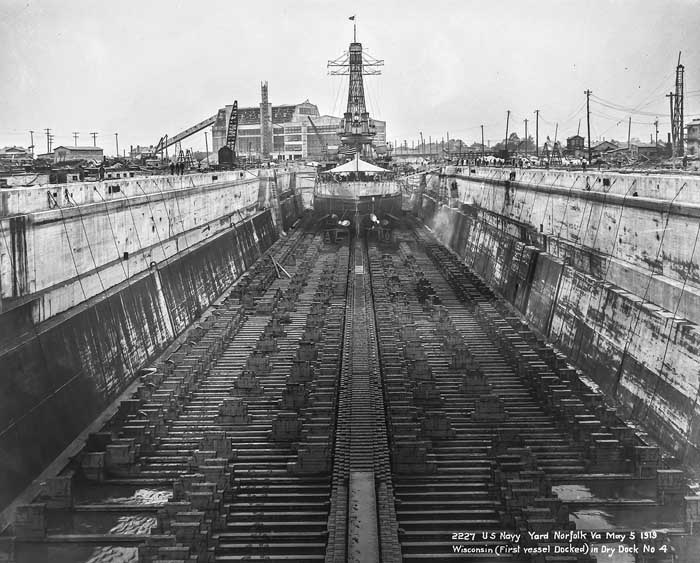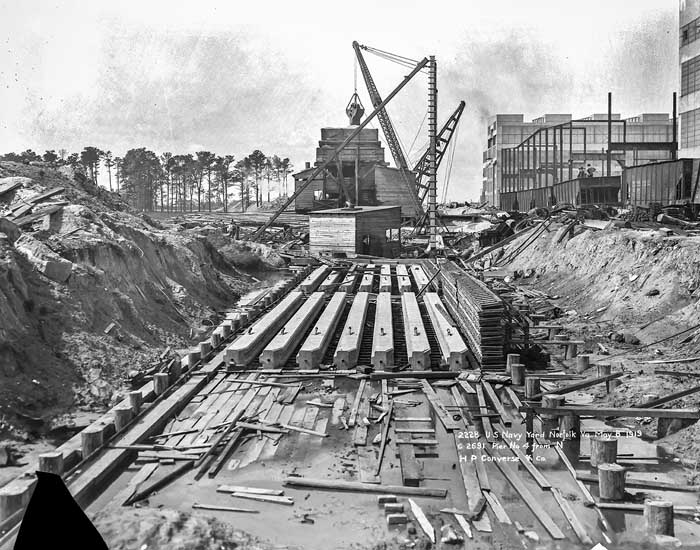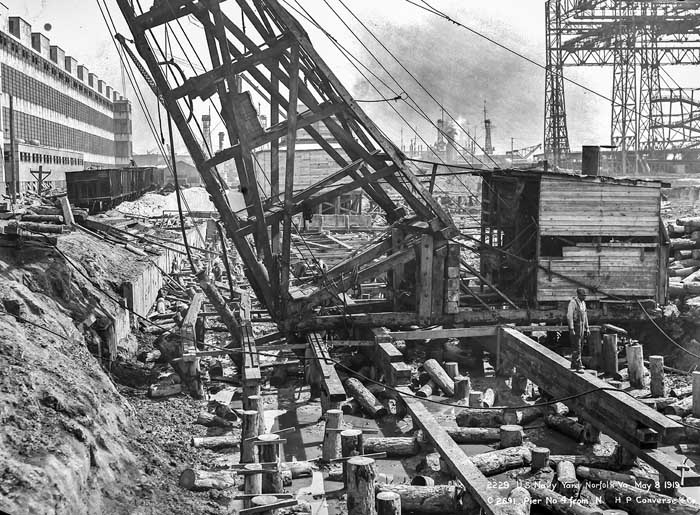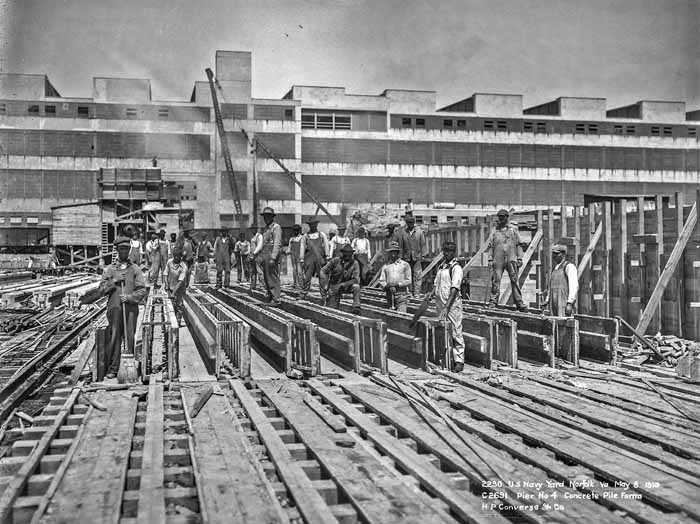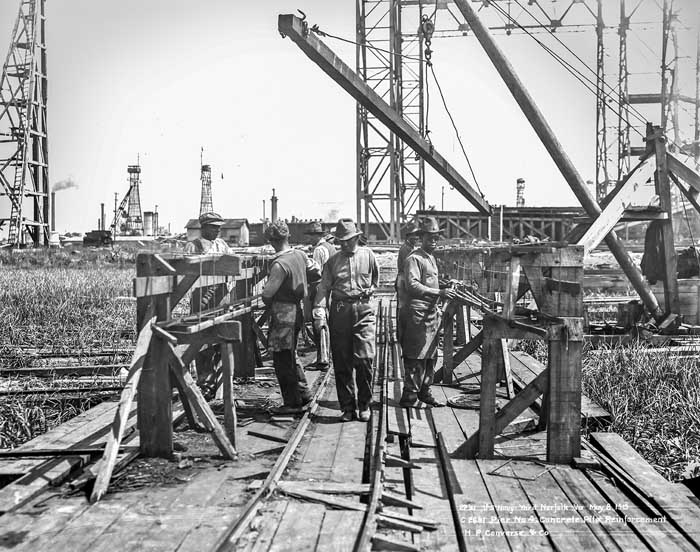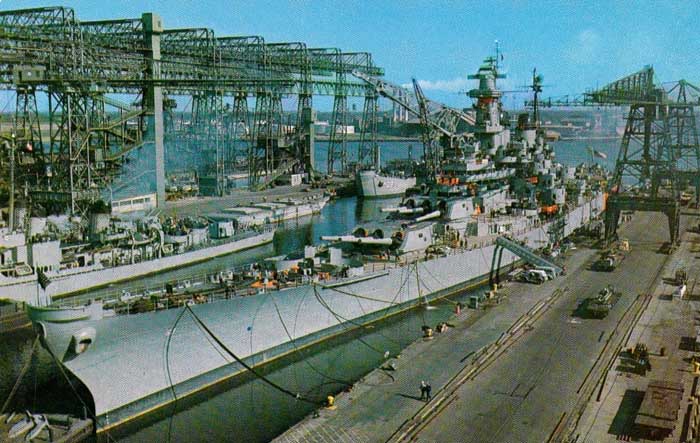
Marcus W. Robbins, Historian & Archivist
Copyright. All rights reserved.
Looking Back at NNSY Waterfront circa 1975
Due to popular demand I am going to begin posting rare postcards, film and glass plate images once a week along with still an occasional longer story in order to share with the workforce just indeed how far we have come by modernizing our facilities knowing that they continue to perform world class ship repair upon these same grounds.
There is so much that has changed in the post card view below. This is the USS Nimitz, CV 68 most likely in the fall of 1975 shortly after acceptance by the Navy as it is berthed at NNSY Pier 3. On October 1, 1975 the ship arrived for a Post Shakedown Availability (PSA) before its first formal Mediterranean deployment in 1976.
USS NIMITZ at Pier 3 NNSY circa 1975
(Commercial postcard courtesy of Marcus W. Robbins)
Look closely at the picture: Building 261 is still an open assembly shed, the old Ship Building Ways has been demolished but not filled in, and the 1920’s Pier 4 is shown center of the photo. It would be another 30 years before the dock crane tracks become interconnected and all the cranes were replaced. Both old Pier 4 and Pier 5 were demolished over the past few years for construction of the new super Pier 5 that opened in 2014.
Also in conclusion for the long time NNSY workers to flashback and the newer ones that might not believe, the photo revels two other long lost facts. Look close and you will see that Hitchcock Street at one time was divided into 4 lanes with private vehicle parking. Wow, times have changed!
Facilities change over the decades hopefully always for the best. It is so very important for our workers to understand the great heritage that came before them and that they take pride in it because – "history matters".
The Cannonball Pile at the Trophy Park
Before we explore this week's installment, I just want to thank everyone as the "History Matters" website blog that I have the honor to publish as the Official Historical Blog of the Norfolk Naval Shipyard has passed a milestone of 20,000 total hits this current week! We have a worldwide readership and the great story of the Norfolk Naval Shipyard continues to go forth.
This week I wanted to focus on a particular long gone item being the cannonball pile at Trophy Park and show you proof positive to what ever happened to it.As you view 100 year old plus postcards of the Navy Yard, you get to look back at commonly known landmarks exactly how they appeared and operated back in the day, yet if you pay close attention, some items can still be seen as surviving to this very day. One iconic local treasure is the crooked tree at the southeast corner of Trophy Park that would have been planted in the post-Civil War layout of Trophy Park, circa 1870. That tree has seen more history under its shadow than any of us ever would know. Another close by item was the cannonball pile.
Trophy Park Cannonball Pile circa 1905
(Postcard courtesy of Marcus W. Robbins)Just an aside to the changes around Trophy Park, in the view above you can see to the left the extreme end of the lawn tennis court backstop, many long gone cannon trophies on display near the street, the first new central power plant distribution poles and, of course, the main entrance as it was constructed in 1851.
What ever happened to the cannonball pile and those other cannon along the eastern edge of Trophy Park at the street? Well, they met their end on January 7, 1943, for a World War II scrap drive, seen in a series of detailed photos I was given from the Portsmouth Naval Shipyard Museum. While I have been doing inventory and research in our own archives, I unearthed the below photo of the cannonball pile.
Trophy Park Scrap Drive 11-17-1947
(Photo courtesy of United States Navy)Operational support to the warfighter always begins with strong facilities back home. Nothing has changed over the years but the landscape of that home front. It is important to recognize someone made a decision that the cannonball pile metal could be put to a better use for the Navy. In closing next time you pass the crooked tree at the south east corner of Trophy Park, reflect on all the things that happened under its shadow because – "history matters".
Two Past Snowfalls at the Navy Yard
We don’t see snow often in eastern Virginia but it sure is fun to look back on what it looked like long ago.
Last year with "History Matters" Blog #28 written on January 29, 2014, I shared some prior snowfall photos of Trophy Park at the Norfolk Navy Yard taken on March 21, 1908, but did not have room then to include all, so I am sharing additional today. Also, I have discovered a couple of long lost photos of a snowfall that feature Quarters A on January 11, 1927. Sit back and enjoy.
Looking North West from Building 13 at Trophy Park
(Historic Norfolk Navy Yard Glass Plate Collection, #550 taken on 3/21/1908)
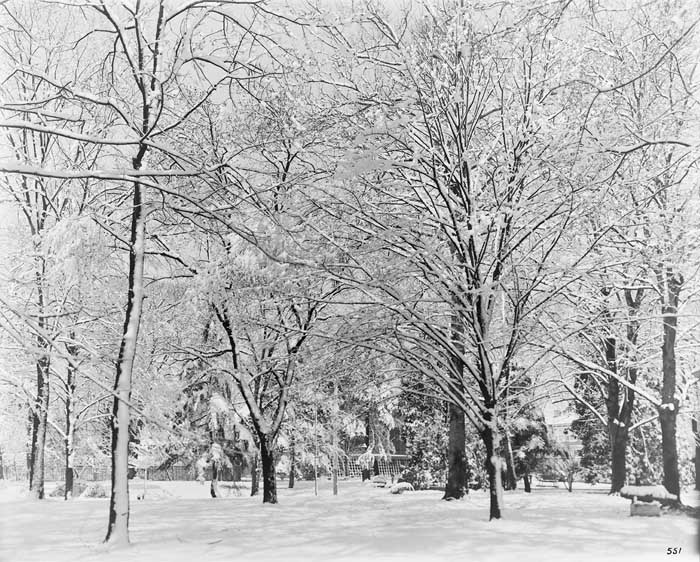
Looking North from Building 13 at Trophy Park
(Historic Norfolk Navy Yard Glass Plate Collection, #551 taken on 3/21/1908)
Looking West at Quarters A side entrance
(Historic Norfolk Navy Yard Glass Plate Collection, #3297 taken on 1/11/1927)
Looking North West at Quarters A
(Historic Norfolk Navy Yard Glass Plate Collection, #3299 taken on 1/11/1927)
The Navy Yard appearance has changed over time but always remains here to provide Service to the Fleet. The very grounds that support and service the fleet has to endure whatever weather Mother Nature provides, including snowfalls. Spring 2015 is only 28 days into the future but these photos serve as a great reminder to where we came from in the distant past because – "history matters".Hercules ~ Navy Yard’s First Locomotive
As the Navy Yard progressed into the modern 1880’s, it left behind at the docks the prior age of wood and sail ship construction. The USS TEXAS, the nation’s first battleship and the USS RALIEGH, the first entirely Government-built cruiser rose upon the ancient 1820’s stone ways that were once covered by the majestic Shiphouse’s "A" & "B".
For anyone familiar with a shipyard, environment weight handling and transport of materials has always been a daunting task. In the age of sail, the "beast of burden" method was utilized daily: horses, mules and oxen. You hear that some of the very NNSY facilities we still use today were once stables - well, there is your proof. Also, the ever ready heavy manual gang labor teams to move items where animals could not be of assistance were commonplace. Shipbuilding has always been back-breaking and labor intensive. In the new modern age as the industrial revolution took hold at the Norfolk Navy Yard in the 1880’s, methods were sought to gain efficiency when it came to transporting extreme heavy loads.
Just as the name implies, "Hercules" is famous for mystic power and strength. The call was made to have a new iron horse to move materials around the Norfolk Navy Yard and thus became our first modern steam locomotive at this place as documented in the below rare photograph.
HERCULES the Norfolk Navy Yard’s First Modern Locomotive, circa 1890’s
(Photo Courtesy of the Portsmouth Naval Shipyard Museum)There was a need to improve our internal railroad track network that was first laid down in 1857, and for whatever survived after the Civil War surly needed replacing and realigning as new buildings and functions adapted along the waterfront into the 1880’s. The 2nd earliest modern rail map that I could locate is shown below showing conditions as found on January 1, 1893.
Click on image to expand in browser
then double click in browser
A Plan of US Navy-Yard Norfolk Va. dated January 1, 1893
(Courtesy US Navy)If you are a regular reader of my "History Matters" writings, you know I love the obscure. Compare the above photo of HURCULES and the small wooden door shed as it is the only picture I have ever seen of Building 4 and a partial one at that. Now, find it on the above map (mid center), as you are looking at the western wall of today’s Building 17 and also see the southern end of Building 15 to the left. For you detectives out there, HURCLES is photographed on a grass plot of what would later become the footprint of today’s Building 65 that was completed in1902.
Old maps and photos serve as a great reminder to where we came from in the distant past. If we realize that some things don’t really change that much over the decades because they were laid out and planned so well, you can begin to understand how this shipyard continues to serve the nation throughout the centuries because – "history matters".
USS Cumberland & USS Congress Memorial of 3/8/1862
Please endure a bit of background first . . .
Looking back at events from the Confederate held Gosport Navy Yard 153 years ago this week, the most revolutionary ship ever produced upon these grounds without question was the Confederate States Ship CSS Virginia. Raised here in 1861 from the sunken and burned USS Merrimac, then converted and launched in 1862 from Dry Dock 1 as the CSS Virginia, Gosport again lead the way in naval architecture and warfare design.
That entire amazing journey of transformation for the CSS Virginia, which first begins with the Union burn of the Gosport Navy Yard (April 21, 1861) along with an expanded summary of the Battle of Hampton Roads (March 8 & 9 1862) and concluding with the Confederate burn of Gosport Navy Yard (May 10, 1862,) has been previously told within my "History Matters" Blogs # 4-20, inclusive, written over the time period of March 18, 2011, to April 22, 2012, as found here if you wish to read the entire run in consecutive order: http://www.usgwarchives.net/va/portsmouth/shipyard/nnyblog.htmYet now look at the title of this Blog. You might ask how does the CSS Virginia fit in with the USS Cumberland and USS Congress and a memorial. Well, the Battle of Hampton Roads that took place here in our local harbor was a two day event. On the 2nd day, CSS Virginia fights to an inclusive draw with the USS Monitor, a story that is well known as these ironclads revolutionized naval warfare worldwide forever.
I want to focus upon that lesser covered 1st day of battle, or should I say the massive death projected upon the USS Cumberland & USS Congress, on a day that marks the end of the age for wooden ships and sail. The CSS Virginia wrought the most damaging naval defeat to the United States Union Navy till the unfortunate events of Pearl Harbor in 1941 right here in our local waters. War by its very nature produces death in the achievement of its dark end game of conquest. No different were the conditions as CSS Virginia sought to break the Union blockade of the Hampton Roads harbor in the spring of 1862.
The Sinking of the Cumberland - oil on canvas at Mariners’ Museum,
(Photo courtesy of Marcus W. Robbins - 150 years of event occurrence)
CSS Virginia engages USS Congress, 8 March 1862
(Navy History & Heritage Command image NH 42216 – painting by F. Muller)Within the Norfolk Naval Shipyard’s historic Trophy Park you can touch iron plate from the CSS Virginia, a gear wheel from the USS Cumberland and a cannon from the USS Congress, all items in which to honor the memories of these three great ships, but it took me driving down the street the United States Naval Hospital Portsmouth, Virginia, last week in order to honor the dead of March 8, 1862.
USS Cumberland and USS Congress Memorial
(Photo courtesy of Marcus W. Robbins 2/27/2015)
USS Cumberland and USS Congress Memorial
(Photo courtesy of Marcus W. Robbins 2/27/2015)How can one learn more about the Battle of Hampton Roads? Well you have the perfect opportunity this coming weekend to visit the fine folks at the Mariners’ Museum, see the attached link for more details: http://www.battleofhamptonroads.com/
In conclusion, remember that our Gosport Navy Yard was the birthplace of the CSS Virginia, a ship whose actions on March 8, 1862, upon the USS Cumberland and USS Congress proved the age of wood and sail was no match to an ironclad ship. A massive loss of life came about that day, but you can right here in Portsmouth, Virginia, see a monument to honor those fallen sailors because – "history matters".
Historical Bronze Plaque at Gate 10
Below is a second installment concerning the bronze plaque found just inside of Gate 10 that I first featured in Blog #31 written on May 12, 2014. I left off at that time with the tease that photos had been uncovered that recorded the unveiling of the historical bronze plaque, and I shall share them below.
I did want to re-purpose and repeat again some of my same text from Blog #31 because it continues to be relevant as we always have new employees and others seeking to understand the great history found here at the Norfolk Naval Shipyard.
Our Norfolk Naval Shipyard lives on today because of the proud accomplishments of not only its past but its promise of the future. It is so very important that new employees here learn of the great milestones we accomplished here on the southern branch of the Elizabeth River, not only for the Navy but for the United States. The one thing I try to tell everyone is history is not just something abstract that happened in the past. The history of our shipyard going into the future depends on you also, the new employee "you must own it".
The historical events story of the Norfolk Naval Shipyard are like a great tapestry; it is woven of many individual fibers all coming together to create something larger. Those fibers begin with our people as they demonstrate pride, knowledge and the craftsmanship of shipbuilding and repair. Those fibers are the tools used and raw materials that are transformed into ships and equipment. Those fibers are the facilities and buildings that are utilized to bring everything together in order to deliver a world class product.
Norfolk Naval Shipyard delivers world class products as evidenced by our motto – "Any Ship, Any Time, Any Where".
One of the best physical artifact tools for learning and teaching a quick overview of our historical events at the Norfolk Naval Shipyard is the bronze plaque inside of Gate 10. I often take new employees there or advise the more seasoned ones to take time to go read what they have driven past for years. It was erected by the Norfolk Naval Shipyard Historical Association in 1950 with the very mission of telling our story.
Click on image to expand in browser
then double click in browser
Bronze Plaque Inside of Gate 10
Text sourced from Marshall W. ButtAnd now, the long promised recent finds from the archives in order to take you back exactly 65 years ago this month (March 27, 1950) to the unveiling ceremony of our most wonderful story teller.
Unveiling Ceremony Program for Historical Plaque, March 27th 1950
Erected by NNSY Historical Association
(Program Courtesy of US Navy)
Unveiling Ceremony for Historical Plaque, March 27th 1950
USS Coral Sea Band Playing
(Photo Courtesy Portsmouth Naval Shipyard Museum)
Unveiling Ceremony for Historical Plaque, March 27th 1950
Looking Northwest Inside Gate 10
(Photo Courtesy Portsmouth Naval Shipyard Museum)
Unveiling Ceremony for Historical Plaque, March 27th 1950
Marshall W. Butt on left
(Photo Courtesy Portsmouth Naval Shipyard Museum)If you read the above text carefully, you shall learn of the four flags this yard has had flown from its flagstaff (British, Virginia, Confederacy & United States) and you shall learn of the three different burns (1779, 1861 & 1862) of the shipyard. From the first dry docking in 1833 of a ship in the United States (USS DELAWARE), our Drydock 1 still remains in operation today, a testament to the craftsman that built it. Other facts contained on the plaque highlight the conversion of the ironclad (CSS VIRGINIA) which was important because it helped change modern naval warfare and it too can trace its heritage to Drydock 1. The US Navy’s first Battleship (USS TEXAS) and the first aircraft carrier (USS LANGLEY) also were constructed here. Finally the plaque gives the various specific dates that this great institution underwent formal name changes.
And so went the events of March 27, 1950 - a mere 65 years ago this current month. Important dates, institution names, flags and milestones supporting the United States Navy was relevant back then to be remembered and continues to be relevant now because –"history matters".
Structures Standing the Test of Time
I get asked all the time about the history of the Navy Yard and people are amazed that routinely most of the old structures were indeed built to stand the test of time. A 100 years old structure around here at NNSY is nothing out of the ordinary when you appreciate the knowledge, skill and craftsmanship that went into producing a quality facility meant to support our Navy.
Let’s have some fun looking back at three common locations that have stood up to the 100 year test of time. These are places you might not have given a second thought about how old they really are. They are just background landscape as you travel past them every day.
1. The Fourth Street Gate (Gate 10) was laid out after the Government bought the adjacent plantation farmland just after 1900. This enabled the western edge of the Navy Yard (at that time) to become connected to the then remote Marine Barracks compound. The entire gate was widened in the 1930’s, otherwise the concrete wall remains unchanged.
Photo #1 ~ Looking Southeast Fourth Street Gate
(Historic Norfolk Navy Yard Glass Plate Collection, #934 taken on 1/23/1914)2. The Portsmouth Naval Hospital was constructed 1827-1830 making it the Navy’s oldest continuously operating hospital. Another set of wings were added onto each side the building supporting World War I but have now been removed in the 2010 timeframe to restore the facility back to its original appearance. Note the original facing stone return at corner of building, further down each side were open porches.
Photo #2 ~ Looking Northwest Portsmouth Navy Hospital
(Historic Norfolk Navy Yard Glass Plate Collection, #340 taken on 5/2/1904)3. The Navy commissioned the first modern submarine USS Holland (SS-1) on 12 October 1900 at Newport, Road Island. Holland finished her career at Norfolk, Virginia, and her name was struck from the Naval Vessel Register on 21 November 1910. Knowing this fact we too had a part in the story of the first modern submarine. In this rare real picture postcard observe that, yes, those are four submarines all at once sitting in Dry Dock # 1.
Submarine Fleet Flotilla in Dry Dock 1
SS-9 Octopus, SS-10 Viper, SS-11 Cuttlefish & SS-12 Tarantula
Real Picture Postcard circa 1909
Courtesy of Marcus W. RobbinsThese are but three places and views in excess of 100 years old you can visit and touch today. Remember that quality construction design, quality materials and extraordinary workmanship have no bounds to the test of time because –"history matters".
1st Ship in Dry Dock #3 ~ USS North Carolina
Our shipyard has always been a home base as vessels call upon the port here on the Southern Branch of the Elizabeth River, sometimes many times throughout their operational lifetime. No different is the story of the USS North Carolina (Armored Cruiser No. 12), the second vessel to hold the name of the great state of North Carolina.
As taken from the Naval History and Heritage Command website the following information is presented about the ship as background to our story.
(Armored Cruiser No. 12: displacement 14,500; length 504'6"; beam 72'11"; draft 25'; speed 22 knots; complement 859; armament 4 10-inch, 16 6-inch, 22 3-inch, 12 3-pounders, 4 1-pounders, 2 .30 cal. machine guns, 4 21-inch torpedo tubes; class Tennessee)
The second North Carolina (Armored Cruiser No. 12) was laid down on 21 March 1905 by Newport News Shipbuilding and Dry Dock Co., Newport News, Va.; launched on 6 October 1906; sponsored by Miss Rebekah Glenn, daughter of the Governor of North Carolina; and commissioned at Norfolk, Va., on 7 May 1908, Captain William A. Marshall in command.And now you know the background on the birth of the ship at Newport News and its operational capacity, look closely again above; the ship was eventually completed and commissioned ready to receive its orders at the Norfolk Navy Yard, as it was known at that time. Our location was well into its second century as a naval operations base for the east coast, as the Norfolk Naval Station still does not come into existence for almost another decade to assume that role just before the 1920’s.
As a vessel shakes down, it begins to operate and achieve its mission, but a shipyard still acts as a home port by providing a place to safely berth, take on supplies and operate from awaiting to receive orders to sail. Such was the condition of USS North Carolina in the below photo very early in its career.
Photo #1 ~ USS North Carolina (on right)
(Historic Norfolk Navy Yard Glass Plate Collection, #607 taken on 10/26/1908)Any place can have a river berth or a pier to safely tie a vessel up to, but what sets apart a true shipyard is its ability to perform drydocking. No different was the story at the Norfolk Navy Yard as on 30 November 1903 Dry Dock #3 began. In future "History Matters" I shall share with you the construction of same, but for now know that the original Dry Dock #3 was formally opened on 8 December 1908. The following two photos show the immediate need to lengthen this same dock which was accomplished in 1910-1911 time frame.
Photo #2 ~ USS North Carolina in Dry Dock #3
(Historic Norfolk Navy Yard Glass Plate Collection, #615 taken on 12/08/1908)
Photo #3 ~ USS North Carolina in Dry Dock #3
(Historic Norfolk Navy Yard Glass Plate Collection, #616 taken on 12/08/1908)The useful inside length of the original construction of Dry Dock #3 was 550 feet and the USS North Carolina was 504 feet and 6 inches. Our Dry Dock #3 was later extended to its present length of 723 feet and 6 inches by 1911. You can again appreciate why, as shown by the following two photos, a pretty snug fit at he time.
Photo #4 ~ USS North Carolina in Dry Dock #3
(Historic Norfolk Navy Yard Glass Plate Collection, #617 taken on 12/09/1908)
Photo #5 ~ USS North Carolina in Dry Dock #3
(Historic Norfolk Navy Yard Glass Plate Collection, #618 taken on 12/09/1908)In conclusion, look upon the final picture: it has so much to tell of our heritage. Yes, this is the location of the modern Dry Dock #3 before another 173 feet and 6 inches were added to the headwall. Note the 1901 construction of the Shipfitter Shop, Building 56, that was located on the southern side of Dry Dock #2 as a large brick structure. There are two horse and carts middle ground a testament to early transportation of materials by shipyard workers. The old Belt Line Railroad swing bridge is visible in the background, also this railroad has always been our southern neighbor in the same location. But what strikes me the most, and I don’t get excited too easily, is the 1830 brick boundary wall that begins in the north of the shipyard at Building 19 is shown here at its end point extending into the river. That brick wall, my friends, is a testament to the endurance that Norfolk represents over the centuries as it was placed to protect the construction of Dry Dock #1.
The middle part of the Norfolk Navy Yard was now ripe for growth to support the nation’s Navy. It is very important to remember how those supporting events unfolded with the construction of dry dock facilities that are unique to a shipyard because –"history matters".
Submarines on the Marine Railway
A true multi-functional shipyard not only can perform work on ships but submarines also. "America’s Shipyard" otherwise known as the Norfolk Naval Shipyard is well into its second century providing this important service to our country. While often overshadowed by larger warships, the submarine repair world is just as important, thus I wanted to provide equal time to honor them with this "History Matters" blog.
We can trace our submarine heritage all the way back to SS-1 USS Holland, which is recognized as the first modern submarine in today’s unbroken chain of under water craft as it was commissioned on 12 October 1900. While it was home ported north of here for most of its career, we decommissioned that same submarine on 21 November 1910, thus continuing on a long line of "first accomplishments" for Norfolk being involved in this new cutting edge marine technology even back in the day. Norfolk can repair and support every vessel the United States Navy operates including submarines and continues that fine tradition to this day.
Anyway, I wanted to share first a very common view of submarines not in dry dock or pier side, as is the common practice today, but on our long gone Marine Railway. Many of you might have seen this view near the site of the current Rusty Anchor Snack Bar as it has been often reproduced and displayed in our work spaces.
Photo #1 ~ USS Moccasin & USS Adder
(Historic Norfolk Navy Yard Glass Plate Collection, #331 taken April 1904)Now look at this rare glass plate view from the other direction and you can see that the location of the Marine Railway was actually to the north of today’s modern Wet Slip #2. In this view and the following views, you can see progress being made as the Wet Slip is created from the ruins of destroyed ex-Shiphouse "C" and its stone building ways of the Civil War era.
Photo #2 ~ Unidentified Small Ship and Submarine on Marine Railway
(Historic Norfolk Navy Yard Glass Plate Collection, #412 circa late 1904)And another view of our work upon an even different submarine, perhaps in the 1905 timeframe. Note the workmen and crew, they seem to be right on top of the job.
Photo #3 ~ unidentified submarine on Marine Railway
(Historic Norfolk Navy Yard Glass Plate Collection, #451 circa 1905)Well, I made reference earlier to the stone building ways and the ruins of ex-Shiphouse "C". I dare say that no one alive today has ever seen this image in person yet, but this postcard from my personal collection confirms the Marine Railway location in great perspective. The large building in the rear is the southern elevation of ex-Building 28, the Mast House, that was constructed in 1828 and the site of Building 1575 that we know today.
Photo #4 ~ Submarine Boat in Navy Yard
(Postcard courtesy of Marcus W. Robbins collection, view circa 1903)And finally a real picture postcard that captures both a Marine and a Sailor way posing for a picture.
Photo #5 ~ USS Moccasin on Marine Railway
(Postcard courtesy of Marcus W. Robbins collection, view circa 1903)In conclusion, I hope you have enjoyed looking back to the earliest support that Norfolk provided to the submarine fleet. While the physical location of the work has changed and the Marine Railway is beyond anyone’s memory, it is still important to know where we came from. Our shipyard has been providing world class service to the United States submarine fleet now into a second century because –"history matters".
The Men That Built Pier 4
An untold number of men have labored day in and day out doing their job constructing Uncle Sam’s shipyard facilities for the United States Navy at America’s Shipyard here on the Southern Branch of the Elizabeth River. Their names were never recorded when photographed and are now lost to time. For sure, these would have been local men, maybe even related to us, that read these words today. Pictures do tell a story, so let us look back 96 years ago this week as Pier 4 was taking shape.
Photo #1 ~ Pier 4 Looking West
(Historic Norfolk Navy Yard Glass Plate Collection, #2182 taken April 12, 1919)In the above photo taken looking west, you can see two large pile drivers and their associated cranes swinging concrete sheet pile into an upright position. Well, the next step would be to drive the pile and repeat many times on both sides of an almost 1,000 foot long structure. It takes a lot of work to build the foundation for a wooden deck relieving platform and earth filled pier such as Pier 4 was. This very pier is later demolished just after the year 2010 to support an even larger new Pier 5 structure, but that is for another story, and thus Pier 4 stands about 90 years total.
Also, while you are gaining your bearings, remember I mentioned the first Pier 5 was constructed some 30 years later, located well to the left in the above photo where you see that pine tree on a swampy finger of land, that will become clearer by the final photo. For you all that know the layout of the shipyard, you can see the original Machine Shop, Building 171 to the left and the extreme southern end of the Structural Shop, Building 163.
But back to the topic of this edition of "History Matters" it is supposed to be about the men that built Pier 4.
Photo #2 ~ Unidentified Men on Pile Driver at Pier 4
(Historic Norfolk Navy Yard Glass Plate Collection, #2183 taken April 12, 1919)And, another view of our workmen, as again crews from both pile drivers have gathered to have their picture taken. What tough and dirty work this must have been.
Photo #3 ~ Unidentified Men on Pile Driver at Pier 4
(Historic Norfolk Navy Yard Glass Plate Collection, #2184 taken April 12, 1919)So fast forward to the month of October 1, 1920, as this is how Pier 4 appeared as Wet Slip 3 to its north and Wet Slip 4 to its south were almost complete of final dredging. Also note the Belt Line Railroad track in the distance has a center swing span, not the high lift of today that we normally see in the raised position.
Photo #4 ~ Pier 4 Looking East
(Historic Norfolk Navy Yard Glass Plate Collection, #2719 taken October 1, 1920)And finally a real American icon of a ship, the USS Arizona that received modernization at the Norfolk Navy Yard along with a drastic physical makeover from May 4, 1929, to becoming fully re-commissioned on March 1, 1931. The location of this final photo is but where else – Pier 4.
Photo #5 ~ Pier 4 Looking South West
(Norfolk Navy Yard Serial No. 142-31. taken on March 2, 1931)These great facilities and piers did not just happen. It took the physical labor of many unknown souls giving an honest day’s hard work for Uncle Sam. The result of their physical efforts is evident both in photographs and the facilities we still use today. Pier 4 most likely outlived most of the men in the above pictures but it is important to remember that their efforts supported our naval history and heritage because –"history matters".
Navy’s First Shot of World War I - April 19th, 1917
We hold an artifact, adjacent to the Norfolk Naval Shipyard on the Path of History, that played an important naval role with our entry into what was once considered the Great War. I wish to share a brief review of a 6-inch gun named "Teddy" in honor of Theodore Roosevelt that was placed upon the aft end of the American Steamship S. S. Mongolia. It was with this gun a group of United States Navy men fired the first successful shot that sank a German submarine on April 19, 1917. This week, 98 years ago marks that historic event and thus begins our "History Matters" reviews with this and future issues leading up to the 100th anniversary of World War I in 2017.
Photo #1 ~ 6-inch Gun from S.S. Mongolia at Path of History
Adjacent to the Norfolk Naval Shipyard
(Photo courtesy of Marcus W. Robbins, taken on April 14, 2015)By 1915 the European Allies were in need of desperate measures to bring in large amounts of gross tonnage: supplies, food and war support items of all types. So various large commercial steamships were outright purchased from private lines and pressed into military support services. At this time America had not entered the Great War and in fact the United States does not declare war on Germany until April 6, 1917. Dates aside, nothing removed the current threat of German submarines and blockading efforts to stop all supplies headed to Europe at all cost. Overseas shipping was not only risky but a deadly business.
It was because of this threat the United States placed 6-inch guns both fore and aft on some of these commercial vessels performing military sea service. S. S. Mongolia encountered a German submarine in the English Channel in which the crew fired, hit and sunk that vessel when it broke surface with its periscope and tower. This was the first shot from an American vessel on the high seas after war had been declared.
This is "Teddy" at sea on the aft end of the S.S. Mongolia from a real picture photo postcard after the conflict. On April 27, 1918, the ship was acquired by the United States Navy and on May 8, 1918, is commissioned USS Mongolia ID 1615. The ship preformed troop transport duties till returned to its owners on September 11, 1919.
Photo #2 ~ Real Picture Postcard
"Teddy" 6-INCH GUN USS MONGOLIA
(Photo courtesy of Marcus W. Robbins)The following text is from the Naval History and Heritage Command:
The ship's after six-inch gun and its crew are pictured in April 1917. The two officers at right are identified, in the original photo caption, as Lieutenant Ware and Captain Emory Rice of the U.S. Naval Reserve Force. Note shells on deck, painted with letters: "T-E-X-A-S" and "T-E-D-D-Y." Mongolia was assigned a Navy armed guard on 17 March 1917. She engaged a German submarine on 19 April 1917, the first U.S. ship encounter with a U-Boat after the United States entered World War I.
Photo #3 ~ Image NH 781
6-Inch Gun on S.S. Mongolia, April 1917
(Photo courtesy of United States Navy)I brought a ladder out to view the upper part of the breach to better observe the small brass plaque that reads:
UNITED STATES NAVAL 6-INCH GUN.
FROM THIS GUN WAS FIRED THE FIRST HOSTILE UNITED STATES SHELL DURING THE WORLD WAR. THE SHELL WAS FIRED AT 5:23 A.M. APRIL 19, 1917 AT A GERMAN SUBMARINE. THE GUN AT THAT TIME WAS MOUNTED ON THE AFTERDECK OF THE S.S. MONGOLIA AND WAS MANNED BY SEVEN SEAMEN BELONGING TO THE UNITED STATES NAVY TRANSFERED FROM THE UNITED STATES NAVY DEPARTMENT.
Photo #4 ~ 6-Inch Gun Brass Plaque from S.S. Mongolia at Path of History
Adjacent to the Norfolk Naval Shipyard
(Photo courtesy of Marcus W. Robbins, taken on April 14, 2015)And finally in closing, something that caught my eye many years ago in my Mother’s barn that she allowed me to have was a heavy paper poster of sorts, a bit frayed and silverfish eaten at the edges yet very cool. I framed it having no idea at the time of the historic significance and how it would tie into the Norfolk Naval Shipyard. It portrays a large waving American flag and a ship underneath with an inscription that reads:
AMERICAN STEAMSHIP
"MONGOLIA" WHOSE GUN FIRED THE
FIRST SHOT FOR THE UNITED STATES ON
APRIL 19TH 1917 and SANK A GERMAN SUBMARINE
Photo #5 ~ S.S. Mongolia War Poster circa 1917
(Photo courtesy of Marcus W. Robbins, taken on April 16, 2015)While we shall mark the 1917 formal entry of the United States into the Great War at 100 years ago in 2017, it is just as important to listen as the drumbeat on the home front was getting louder by the month well before that as these commercial vessels were armed and crewed by the Navy to protect both the Allies and American interests. The Norfolk Navy Yard, and for that matter the entire country, was about to be forever changed because of this very 6-inch gun that is within a couple of baseball throws from the northern shipyard wall today because –"history matters".
The Flag of the CSS Hampton Returns Home
"In the museum business, if you are lucky, you occasionally have an opportunity to experience what we call ‘wow’ moments." – Elizabeth A. Poulliot, HRNM Director
On the evening April 22, 2015, I was in attendance at the Hampton Roads Naval Museum to witness the return home of the flag that flew from the Confederate States Ship – CSS Hampton. We built the Maury style gunboat CSS Hampton here at the Gosport Navy Yard in 1862; it is a part of our local heritage. As we close out a four year remembrance – The Civil War Navy Sesquicentennial 1861-1865, what better place than about a mile from the old Gosport shipyard to celebrate a rare relic’s return home.
To have an actual surviving item with direct ties to the Confederate Gosport Navy Yard is indeed rare. This flag represents a little known story of the various small gunboats built at Gosport in 1862 after the famous CSS Virginia is built. The flag also documents the eventual fate of CSS Hampton at the fall of Richmond in 1865.
A flag invokes strong feelings of both honor and just cause and when placed in theater it is what makes the war machine function; one side against the other - it is what is fought for and what is fought against. Looking back with historical context, this is a story of both luck and timing for the artifact itself. Most cloth relics never survive the elements over time but against all odds this one did. This flag not only wraps itself with mysteries only known now to the wind but also shares many documented twist and turns in its long journey back home.
Photo #1 ~ CSS Hampton Flag at Dayton, Virginia
(Photo courtesy of Civil War Navy Sesquicentennial Blog - August 2, 2013)Now how did this naval flag get into a local museum’s collection in the town of Dayton, Virginia, west of the Shenandoah National Park? Again, I refer to the Navy’s Civil War Navy Sesquicentennial Blog - August 2, 2013, that I present here in total as it tells the story the best:
Richmond, Virginia: 1865
Virginia stood wounded and defeated in the last two years of war. After suffering heavy casualties throughout Grant’s Overland Campaign, Virginia’s army braced their backs to the south of Richmond at Petersburg in June 1864. To the west, Virginia’s lush and vibrant Shenandoah Valley burned, denying much needed food and supplies to the starving at Petersburg. By March 1865, the Petersburg campaign was over. One month later, approaching Federal armies captured the Confederate capitol. Richmond remained a burned-out husk of its former self. The Confederate military was gone and much of its population deserted. It seems that the war would be over. Yet victory did not come without its spoils.
In the midst of the desolation and destruction, Lieutenant William J. Ladd of the 13th New Hampshire Regiment stood alone in the deserted city Capitol. According to the history of the regiment, Ladd rode towards Rocketts landing and found a Union cavalryman. The two rowed out onto the James, where they pulled down two flags off of the CSS Hampton, one of two Maury that saw action during the American Civil War. Little did they know, the Confederates rigged the ship to explode. Minutes after they rowed back ashore, the ship went up in a fiery blaze; symbolic of the Navy’s demise and that of its most prized city.
Dayton, VA: 2011Ladd kept the flag after the war at his home in Milton. In the 1960s, the flag made its way to Dayton, VA, and into the hands of the Harrisonburg-Rockingham Historical Society (HRHS). The flag that once flew defiantly against the government of the United States lay in a collection's box. Nancy Hess, Vice President of the society, came across the discovery in 2011. Included with the flag was a handwritten inscription sewn onto the flag:
The flag was a terrific find. Yet it remained in extreme disrepair. The board at the HRHS decided to look for a new home for the flag, eventually reaching Captain H.J. Hendrix, Director of the Naval History and Heritage Command. Captain Hendrix offered to see to the flag’s conversation and care.
Dayton, VA: 2013
In front of a crowd of nearly fifty people, Captain H. J. Hendrix, NHHC Director, accepted the flag of the Hampton on behalf of the U.S. Navy. After a long journey, the flag will be preserved and displayed at the Hampton Roads Naval Museum (HRNM) in Norfolk, VA. Elizabeth Poulliot, HRNM Director, will gladly work with Washington, D.C. to see the flag make it to Norfolk. What better place to preserve the history of the gunboat than near the place where it was built across the Elizabeth River?
The flag is an important piece that helps us understand the importance of the Confederate Navy in Hampton Roads. Poulliot plans to "to prominently display it in our Civil War gallery." She added that visitors will "want to learn more about the Civil War, and how the Confederacy built Maury gunboats. The acceptance of this ensign from CSS Hampton is an honor for our institution."And now some additional background about what it was like here at Gosport in 1862. Matthew Fontaine Maury, one of the Confederate Navy’s foremost nautical scientists (Maury High School in Norfolk, Virginia, is named for him) was a proponent of building a fleet of gunboats to swarm like bees to sting the Union warships to death. Other than the one additional ironsides being the CSS Richmond (CSS Virginia II) that is launched here in 1862, we find that the Confederates have multiple launching ways at Gosport and become busy constructing the Maury gunboats. It is a program that is dashed and doomed from the start after the Battle of Hampton Roads outcome as wooden shipbuilding soon shall come to a quick end but, faced with desperate times, Confederate Gosport presses on regardless.
Only the CSS Nansemond and CSS Hampton, each being 80 tons, wooden hull, steam screw with two guns, were in the water and began service also in 1862 along with the CSS Richmond before the Confederates abandon and burn the yard on May 10, 1862. Five uncompleted ships under the supervision of John Luke Porter are burned on the stocks to prevent capture at Gosport being the: Norfolk, Portsmouth, Escambia, Elizabeth and the Yadkin.
Photo #2 ~ CSS Nansemond
(Photo courtesy of Hampton Roads Naval Museum)So how close was this flag to becoming just a memory? Again, I defer to my friends at the Navy with their research as the following puts things in perspective:
It was early morning as Lt. William Ladd rode his horse into a nearly deserted Richmond, Va. The siege of the Petersburg had come to an end after eight months, signifying an end to the war that had divided America. With the Confederate capital of Richmond captured, the last hopes of the rebel army vanished and the army and populace of the city had scattered. It was while investigating the city that Ladd observed a Confederate ship flying their colors.
"I was in the Capitol grounds as early as 5:30 am," wrote Ladd, in the History of the 13th New Hampshire Regiment. "I saw no flag on the Capitol at that time. After looking about the grounds and vicinity for a few minutes, and realizing I was alone in the city, I rode back towards Rocketts, and when near there met a white Union cavalryman - the first Union soldier I had seen in Richmond that morning. We tied our horses, took a skiff and rowed out to a rebel war ship in the James, and captured two Confederate flags then flying upon her. I pulled down the larger flag, the cavalryman the smaller one, and we rolled them up and tied them to our saddles."
Unknown to Ladd, the Confederates had previously rigged the ship, Confederate States Ship (CSS) Hampton, to explode, denying the Union Army its capture. Soon after he and the cavalryman left with their captured flags, the ship was rocked by an explosion and slowly sank into the waters of the James River.
On the night of April 22, 2015, we are treated to a lecture by Mr. Kenneth D. Alford that shares information about nautical and battle flags found while writing his recent book – Civil War Museum Treasures: Outstanding Artifacts and the Stories Behind Them. Also in attendance is Nancy Hess from The Heritage Museum, Volunteer and Board Member. Standing with them in the center is Elizabeth A. Poulliot, Hampton Roads Naval Museum Director. The time had come to unveil and acknowledge the return of the CSS Hampton flag to a permanent location both for public display and education purposes. The flag of the CSS Hampton returns home to the same riverfront where it last sailed 153 years prior.
Photo #3 ~ CSS Hampton Flag at HRNM
Unveiling on April 22, 2015
(Photo courtesy of Marcus W. Robbins)And of course as this was a public event I took the opportunity to capture an image of a great friend of mine, Mr. Stephen Milner, a prior long time Public Affairs Officer at the Norfolk Naval Shipyard. I teased with him later when we looked at the picture I had taken as he was holding his hat in such a way that the Norfolk Naval Shipyard showed very well, its great naval tradition continues. Also I mentioned that it was unfortunate that over time he has lost a bit of hair, the same as over time the CSS Hampton flag had lost some of its stars but in the end are both of them were survivors.
Photo #4 ~ CSS Hampton Flag at HRNM
Unveiling on April 22, 2015
(Photo courtesy of Marcus W. Robbins)The historical plaque within the display case reads as follows below:
Photo #5 ~ CSS Hampton Flag Plaque at HRNM
Unveiling on April 22, 2015
(Photo courtesy of Marcus W. Robbins)I invite you to visit the Hampton Roads Naval Museum located at One Waterside Drive in Norfolk, Virginia, because not only is it home to a world class Civil War gallery but the entire museum pays honor to the Navy with a special emphasis on this location (Hampton Roads) including our Norfolk Naval Shipyard in Portsmouth, Virginia, and the Norfolk Naval Station located in Norfolk, Virginia. A link for the HRNM website is found here:
http://www.history.navy.mil/museums/hrnm/index.html
Should you wish to join the museum’s foundation and find out how to get your own quarterly edition of the Daybook (next month in May 2015 has more on the CSS Hampton) or volunteer your services, please phone directly to Elizabeth (Becky) Poulliot, Hampton Roads Naval Museum Director at (757) 322-2990.
Remember, naval history is all around us here in eastern Virginia, go visit it today because –"history matters".
1st Ship in Dry Dock #4 ~ USS Wisconsin
Drydock 4 at the Norfolk Navy Yard was at one time the largest concrete structure in the world. With a usable length of 1,110 feet 10inches and a floor thickness of 20feet, it can be summarized in one word – "massive”. With a future "History Matters," I shall write and feature photos of the construction of same.
This current week, the NNSY Facebook page posted another one of the many informative sign plaques found outside our northern wall along the Path of History. That sign pertained to a quick overview of Dry Dock #’s 1, 2, 3, 4, 6, 7 & 8. While this blog will look specifically at Dry Dock #4 and the docking of the first ship therein, let me put the following mystery issue to rest.
Photo #1 ~ Path of History Plaque
(Photo Courtesy of Marcus W. Robbins taken on 01/21/2013)Where was or why was there not a Dry Dock #5? No, it is not the inner secondary cassion seat of Drydock #4 as originally built. Dry Dock #5 was to be a twin to the immediate south and share the southern side traveling dock crane rail of Dry Dock #4. All of this is proven on a rare station map: PW 4707 – Proposed Final Layout for Development United States Navy Yard Norfolk, Virginia dated 28 December 1917. The site later becomes the footprint for Building 261 and is eventually added onto with Building 1579.
So let’s get back to Dry Dock #4. As a structure, it is begun on 8 January 1917 and is declared completed on 1 April 1919.
The 1st ship to enter the Navy’s largest dock to that time is the USS Wisconsin as shown in the below photos, a mere 96 years ago this week. Dry Dock #4 has been in continual service to the fleet for an almost full 10 decades.
Photo #2 ~ USS Wisconsin
(Historic Norfolk Navy Yard Glass Plate Collection, #2225 taken on 5/5/1919)As taken from the Naval History and Heritage Command website, the following information is presented about the ship as background to our story.
The first Wisconsin (Battleship No. 9) was laid down on 9 February 1897 at San Francisco, Calif., by the Union Iron Works; launched on 26 November 1898; sponsored by Miss Elizabeth Stephenson, the daughter of Senator Isaac Stephenson of Marinette, Wis., and commissioned on 4 February 1901, Capt. George C. Reiter in command.
Then 19 years of full operational service follows… and finally:
Placed out of commission on 15 May 1920, Wisconsin was reclassified BB-9 on 17 July 1920, while awaiting disposition. She was sold for scrap on 26 January 1922 as a result of the Washington Treaty.The ship meets the end of its famous career and is laid to rest at Norfolk until it is sold for scrap after World War I. As in any deactivation, the docking period is critical: Dry Dock #4 provided the needed dry dock facility to support USS Wisconsin’s final mission.
Photo #3 ~ USS Wisconsin
(Historic Norfolk Navy Yard Glass Plate Collection, #2226 taken on 5/5/1919)Again, as I repeated in an earlier blog about Dry Dock #3 a couple of months ago, it is true that any place can have a river berth or a pier to safely tie a vessel up to, but what sets apart a true shipyard is its ability to perform dry docking. This location being the Norfolk Navy Yard along the Elizabeth River has the ability to take any vessel of Uncle Sam’s Navy out of its natural element (water) and allows it to become docked (dry) so craftsmen may preform repairs.
Photo #4 ~ USS Wisconsin
(Historic Norfolk Navy Yard Glass Plate Collection, #2227 taken on 5/5/1919)This final picture of the USS Wisconsin’s stern is a fitting way to say good bye as now we know its story and operational career. But for a moment focus upon the facility of Dry Dock #4 itself; I conclude with the same word I started with –"massive".
Dry Dock #4 has provided the United States Navy with over 96 years of nearly continuous service here at "America’s Shipyard” because –"history matters".
Pier 4 Construction 96 Years Ago
Pier 4 is nothing but a memory now but in its day it served our nation well.
As we continue to look back on how World War I changed the Norfolk Navy Yard, both before and after the Great War, nothing defines progress along the waterfront like the visual impact of a huge capital improvement project. A few weeks ago (April 10, 2015) with "History Matters" Blog #47 ~ The Men That Built Pier 4, we focused first on the crew of the pile drivers and then provided some overview photos as the pier took shape.
Ask any historian, dates of a time past are cool reminders of what happened back in the day even if they don’t fall exactly on a key anniversary, such as 10, 50 or 100 years ago. As I woke up this morning without a clue to what I would write on today (retirement has been treating me very well), I did what every married man should do (remember his own anniversary) and then wished my beautiful wife Jo Ann a happy anniversary and for providing us a great 33 years so far. Our journey together began formally on May 8, 1982. By that time I had already been working at Norfolk Naval Shipyard for going on five years.
Thus it was pretty cool that I discovered the following four glass plate images, all taken on May 8, 1919, a mere 96 years to the exact date of today concerning the ongoing progress of Pier 4. As I have stated before about the men that built our facilities, their names were never recorded when the photos were taken and now they too are lost to time. For sure these would have been local men, maybe even related to us, that read these words today. Pictures do tell a story so let us look back 96 years ago this very day as Pier 4 was continuing to take shape.
Photo #1 ~ Pier 4 Head Looking South
(Historic Norfolk Navy Yard Glass Plate Collection, #2228 taken May 8, 1919)Yes folks, that is of what you would know today as Hitchcock Street, looking south. Building 163 is on the right, Building 202 is yet to be constructed and the first part of Building 171 is further in the view. Where the pine trees are seen in the distance, well, World War II will take care of them as that is the eventual site of Pier 6.
Photo #2 ~ Pier 4 Head Looking North
(Historic Norfolk Navy Yard Glass Plate Collection, #2229 taken May 8, 1919)Again, Building 163 is shown now to the left and towering in the skyline on the right is the massive Ship Building Ways that is the site of many launchings over the years for ships constructed at Norfolk. It is from this structure we launch the battleship Alabama and three aircraft carries in World War II but that is a story for another time. In the far distance the cage masts of a pre-World War I battleship are visible.
Photo #3 ~ Pier 4 Looking West
(Historic Norfolk Navy Yard Glass Plate Collection, #2230 taken May 8, 1919)In the above photo here are the "real men" that built Pier 4. It was not easy work but again nothing worthwhile comes without a price. Here you see the crew taking a pause as they form concrete piles that eventually supported the deck of Pier 4. Construction of a ship repair pier is somewhat like an iceberg, the heavy supporting elements are not ever seen on the surface.
Photo #4 ~ Pier 4 General Construction View
(Historic Norfolk Navy Yard Glass Plate Collection, #2231 taken May 8, 1919)The huge Schmoele tract of land that had been purchased a couple of decades prior has now begun to become developed and the yard is growing to the south as you can see all the marsh grass. It indeed was a different environment back then to construct a shipyard waterfront but there was vision. Pier 4 serves us well for World War II, then with the Korean & Vietnam Wars - about 90 years till it is removed to support the construction of the super carrier Pier 5 of modern times that has just completed.
Photo #5 ~ Pier 4 Looking East
USS Missouri circa 1952
(Courtesy of Marcus W. Robbins, commercial postcard image)The final view above is a postcard view from the early 1950’s. Without much further comment, it provides to many of us the reminder of how America’s majestic war ships can come back into a port for much needed repairs. It is because of our great facilities and our huge repair piers that we at Norfolk Naval Shipyard continue to serve the nation.
In closing, a theme of today was about dates. Our own 250th anniversary is just around the corner in 2017. There will be so much to look back upon and I’m already looking forward to it because –"history matters".
Norfolk Navy Yard Table of Contents
